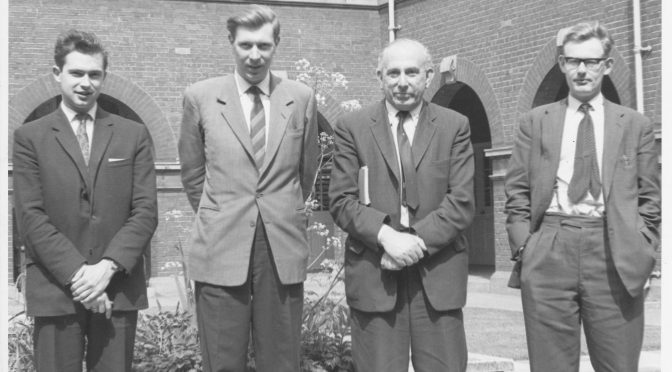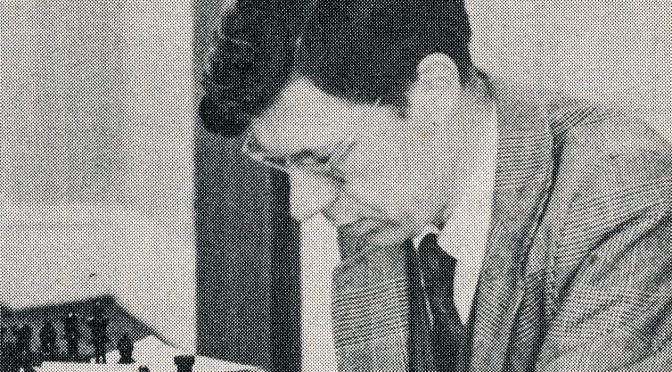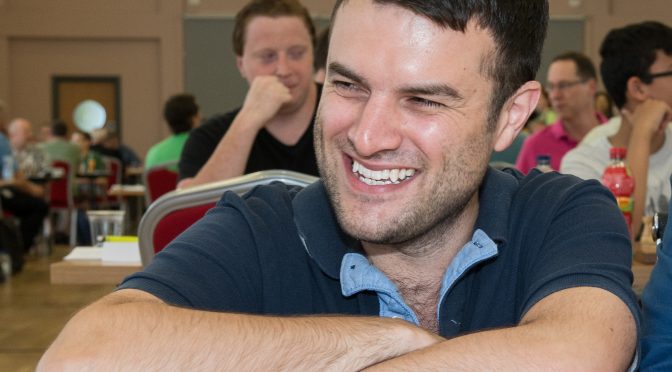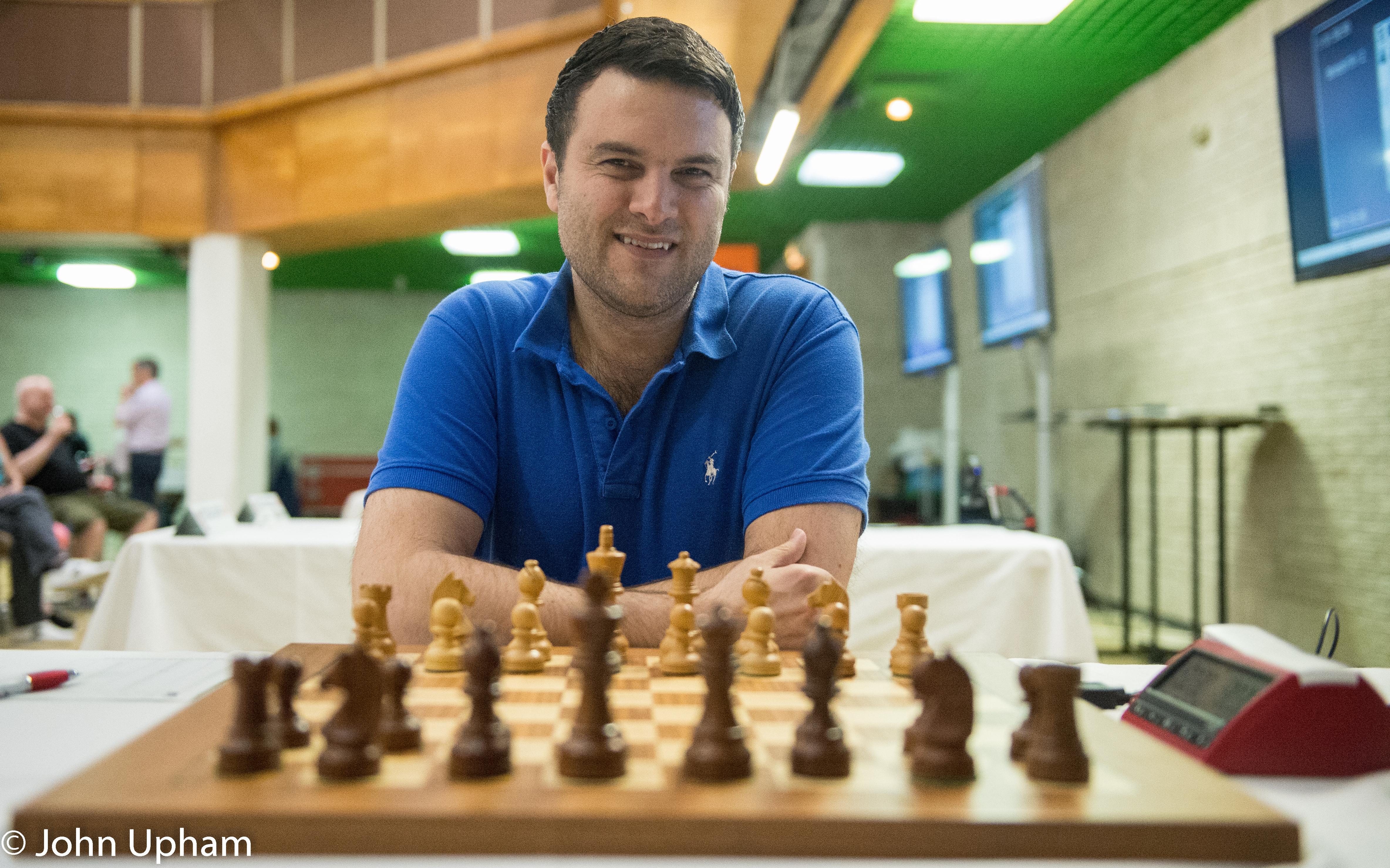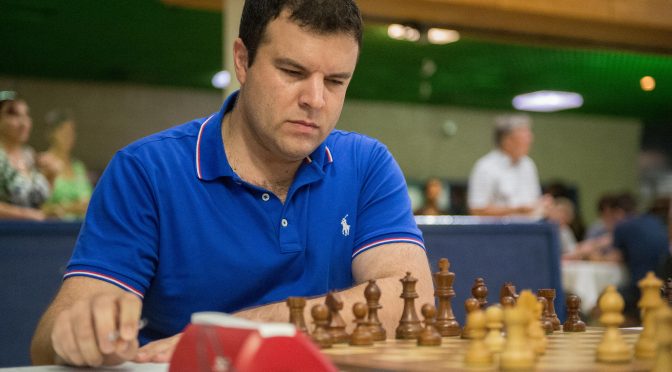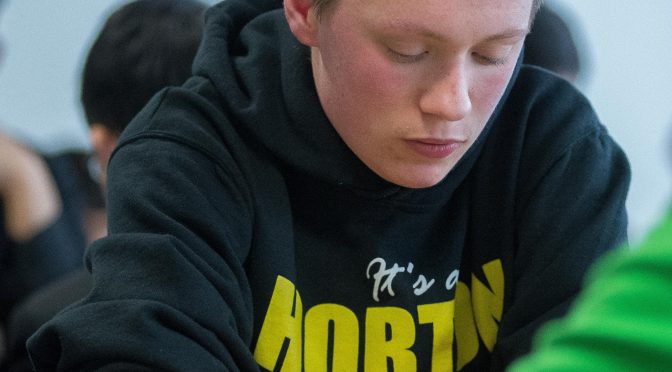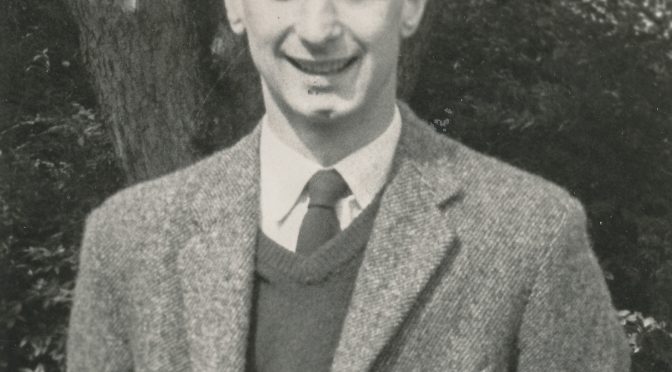Birthday of FM Owen Mark Hindle (14-iii-1940)
Tag Archives: English
Remembering FM Mike Franklin (02-ii-1931 25-iv-2023)
BCN is sorry to report the passing of FM Mike Franklin on Tuesday April 25th 2023: one of England’s most respected and well regarded players.
Growing Up
Michael John Franklin was born on Monday, February 2nd, 1931 in Battersea, London to Albert George (27 ix 1906, Dover – ? iii 1983, Wandsworth) and Helen Ann Franklin (née Colson, 1908-2003) who married in the third quarter of 1928 in Wandsworth. Albert was a clerk as was his father.
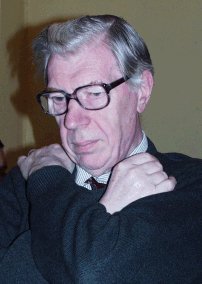
At the commencement of the Second World War, when eight years old, Michael was evacuated to Frome in Somerset. As a consequence Michael would delight in playing in the Frome Congress whenever possible. He played in the first event in 1990 organised by Leon York (whose name is the memorial trophy for the Major section). The story of Michael’s return to Frome made its’ way in to the local newspaper and was reported by Gary Lane as follows :
From British Chess Magazine, Volume CX (110, 1990), Number 7 (July), page 296 :
“A special presentation by the sponsor, Mrs. Jean Mackereth, Managing Director of Keyford Frames, was made to Londoner Michael Franklin, who was returning for the first time in 51 years to the town to which he was evacuated during the war. His final appearance at Frome was in the 2010 event.
The Early Years
Michaels interest in chess started in 1944 aged 13 when he witnessed games being played on Clapham Common. He was fascinated by the pieces and taught himself to play, never receiving any formal coaching. He joined the Clapham Common Chess Club in 1944. (CCCC became incorporated into Battersea Chess Club some time later).
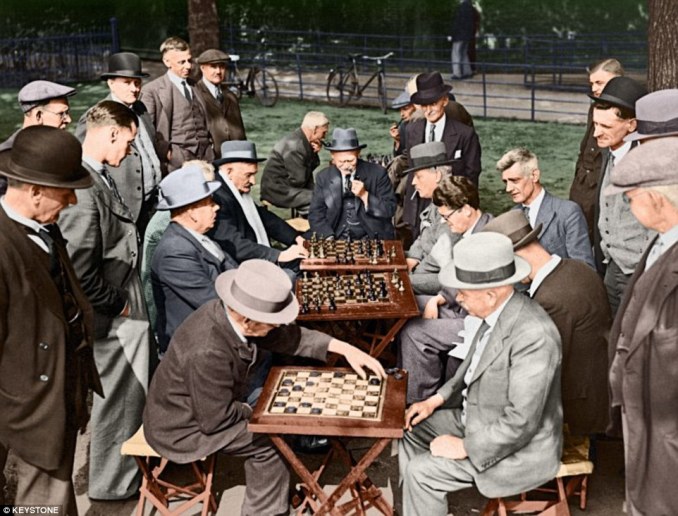
Apart from summer events such as the above the club had a Winter Section that played matches in the London League. The club won the first division (now known as the Brian Smith Trophy) of the London League in the 1946-47 and 1947-48 seasons. Michael played his final game in the London Chess League for Richmond & Twickenham on April 14th 2010 drawing with John Hodgson, giving a sixty year span.
In his formative years he played at the Gambit Chess Café, Budge Row, Cannon Street, London, EC4N. Many strong players regularly visited the Gambit to play skittles, blitz and the frequently held lightning tournaments hosted by the proprietor Mr GH White.
Events such as these enabled Michael to develop his quick sight of the board and his flair for tactical play.
Leonard Barden added:
“Michael made his name as a young player first by his successes in the Saturday evening Gambit Guinea speed events at the Gambit Chess Café in Cannon Street which he often won ahead of master level rivals. He remained a strong speed player all his life.”
In the early 1950s Michael was persuaded by his friends Aird Thomson (who was Scottish Boys’ Champion in 1932, and 1933 ( equal-first). In 1951 he was Scottish Champion. In 1954 he moved to London. He married Susan Mary Hamilton in 1961 who went on to become Scottish Ladies’ Champion in 1965.) and oriental carpet expert Robert Pinner to join the Richmond and Twickenham Chess Club playing for the club in the London League, Surrey Trophy and National Club Championship until he retired from competitive play 2010.
Making Progress
Michael’s first appearance in British Chess Magazine was in Volume LXVI (66, 1946), Number 2 (February). Page 52 contained this report of the 1945 London Boy’s Championship in which Michael reached the final A section :
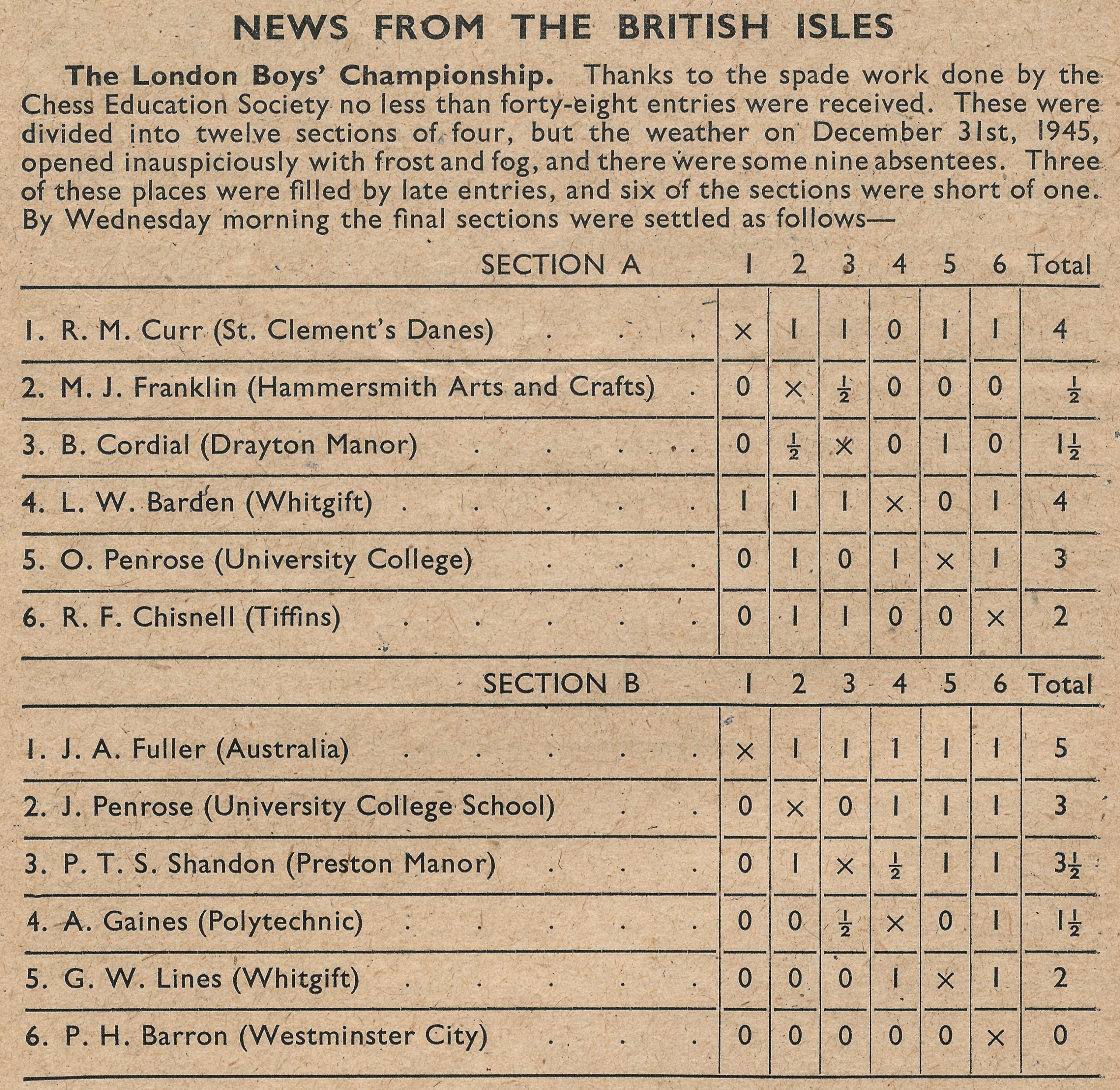
Michael’s club (for this event) is recorded as Hammersmith Arts and Crafts School.
On leaving school Michael joined a firm of Patent Agents remaining in their employ in the accounts department for around forty years before retiring in the late 1980s. His retirement was prompted by the firm’s adoption of electronic computers. When he retired he was Chief Cashier.
On June 18th 1960 Michael’s happiest day was when he married Jean Fey. They celebrated their diamond anniversary in 2020.
For the rest of his life Michael has maintained an aversion toward modern technology. He did, however, concede to the ownership of a mobile telephone. This was for the specific purpose of updating Jean on his days progress in any chess tournaments where he was away from home.
In 1946 (aged 15) Michael won the Felce Cup awarded by the Surrey County Chess Association. A result indicating rapid improvement since Michael had only started playing competitively in 1944.
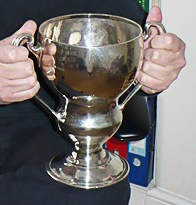
In 1951 Michael finished third in the Surrey Championships behind the winner Frank Parr and runner-up David Hooper. In 1961, 1966, 1968, 1969 and 1970 Michael won the Surrey Championship outright and made many appearences in county matches for Surrey from 1950 onwards until 2010.
Unfortunately Michael’s rapid progress was threatened by two bouts of ill health. In 1948 aged 17 Michael was diagnosed with Tuberculosis which lasted for eighteen months including a twelve month stay in the Royal National Hospital for Diseases of the Chest in Ventnor on the Isle of Wight. Aged twenty the TB returned leading to yet another twelve months illness.
Michael has suffered from ill health all of his life interrupting his chess career at various times. Fortunately the TB never returned.
Michael won the National Chess Centre Championship in 1953 and 1955 being runner-up in 1954. The venue was Hill’s Restaurant, 158 Bishopsgate, London, EC2 opposite Liverpool Street Station since the original John Lewis department store venue was bombed in 1940.
Results from the 1955 event:
1-2 Franklin, Fazekas 3.5/5
3 Fuller 3/5
4 Barden 2.5/5
5 Parr 1/5
6 Green 0.5/5
Michael won the play-off 2-0.
The British Chess Federation first published a National Grading list in 1953 (using the Richard Clarke system). In the 1954 list MF appeared with a grade of 2A (225-232) and from then on with a grade of either 2A or 2B. In 1964 a numeric system had him at 225 ranking Michael 4th in England behind Penrose 244, Kottnauer 238 and Clarke 231.
Michael played many times in the annual Battle of Britain Tournament organised by Squadron Leader David Pritchard and his committee. He won it four times : 1959, 1960, 1961 and 1962.
The Ilford Whitsun Congress
The Ilford Whitsun Congress was a regular part of Michael’s season throughout the sixties. He won the Premier Reserves in 1961 ahead of Hilton, Hindle, Howson, Sales and Blaine and was runner-up to Kottnauer in 1962. In 1963 he went one step better by winning the Premier :
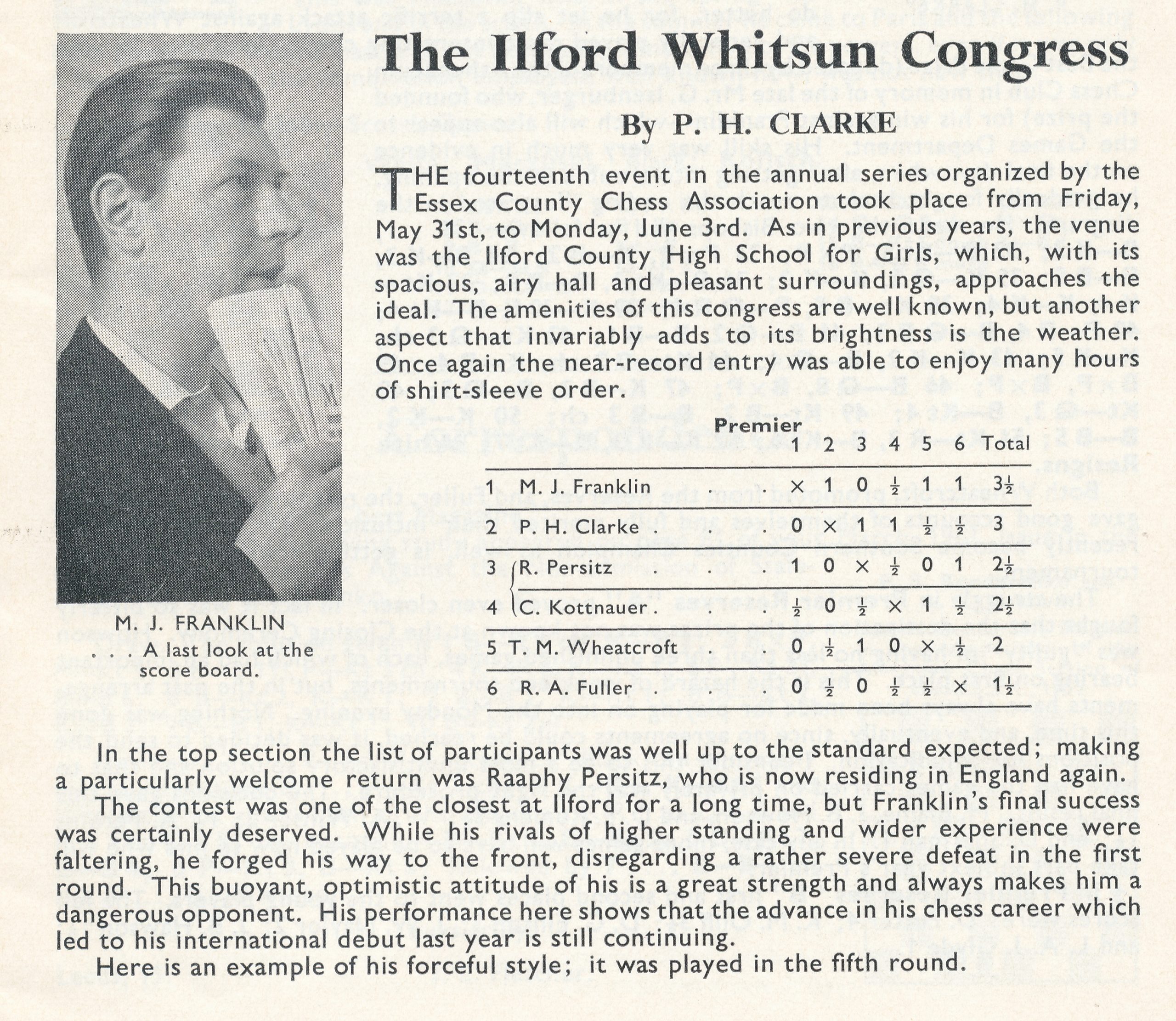
and here is the fifth round game :
In his tournament report PH Clarke wrote :
This buoyant, optimistic attitude of his is a great strength and always makes him a dangerous opponent.
Away from Home : International Progress
1964 saw selection by the BCF to play in the Tel Aviv Olympiad :

and scored a creditable 4/6. This was followed in 1965 with 3/5 in Clare Benedict tournament held in Berlin.
He played in the annual Anglo-Dutch match on no less than six occasions in 1962, 1963, 1964, 1965, 1968 and finally in 1969. His aggregate score was an impressive 8/12.
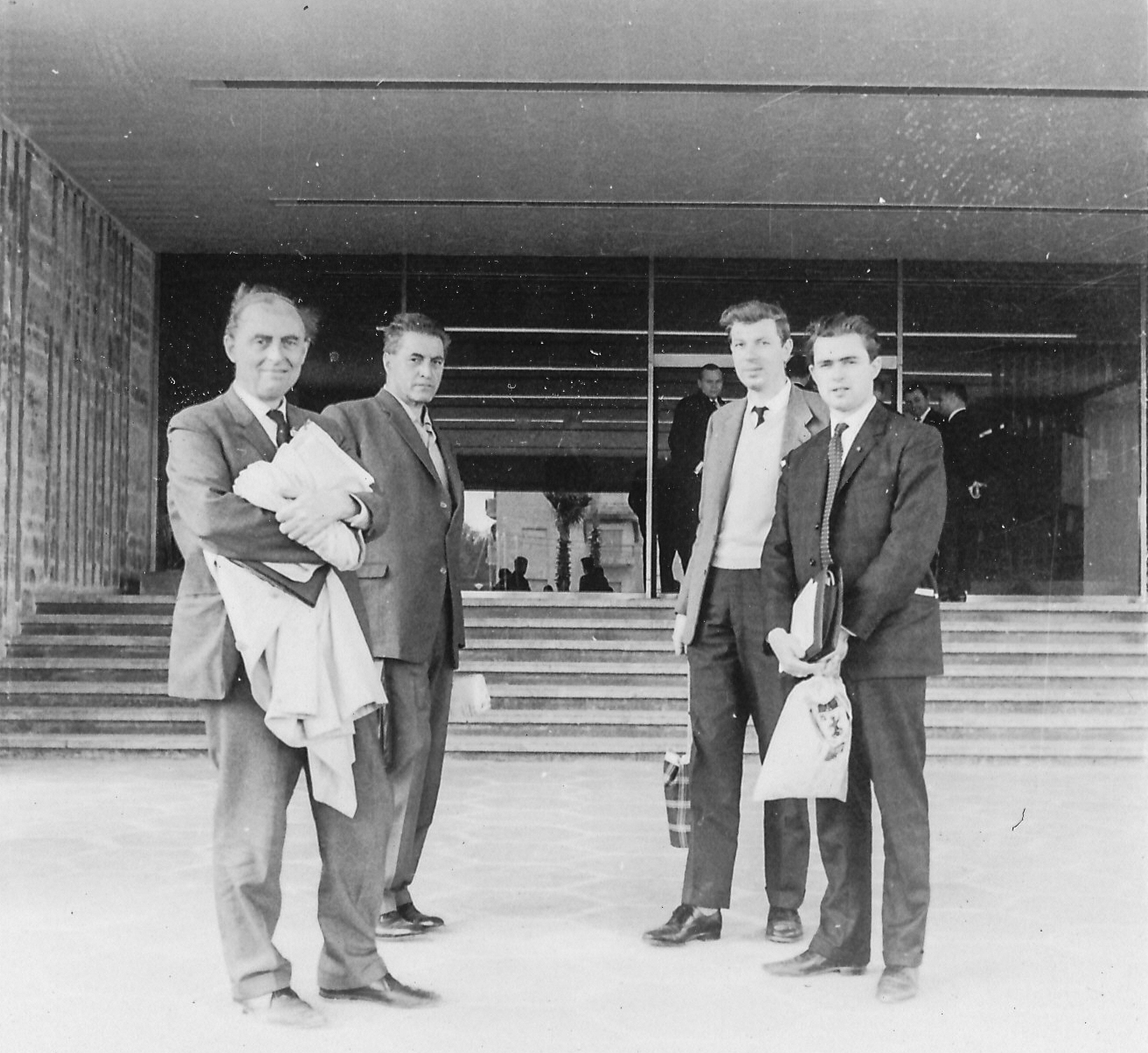
On the national scene Michael repeated his 1963 victory at the 1969 Ilford Premier with a clear first place : Franklin 4; RG Wade and D Wright 3; JB Howson 2.5; BH Wood 2; PH Clarke 0.5.
In 1970 Michael won the London Championship which was also known as the Budget Cup which had last been held in 1956 . He followed this in 1972 by rightly earning the (now defunct) title of British Master.
Michael’s final appearance for England was in 1971 in the Cheltenham based Anglo-German match with a somewhat disappointing 0.5/2 against Juergen Dueball.
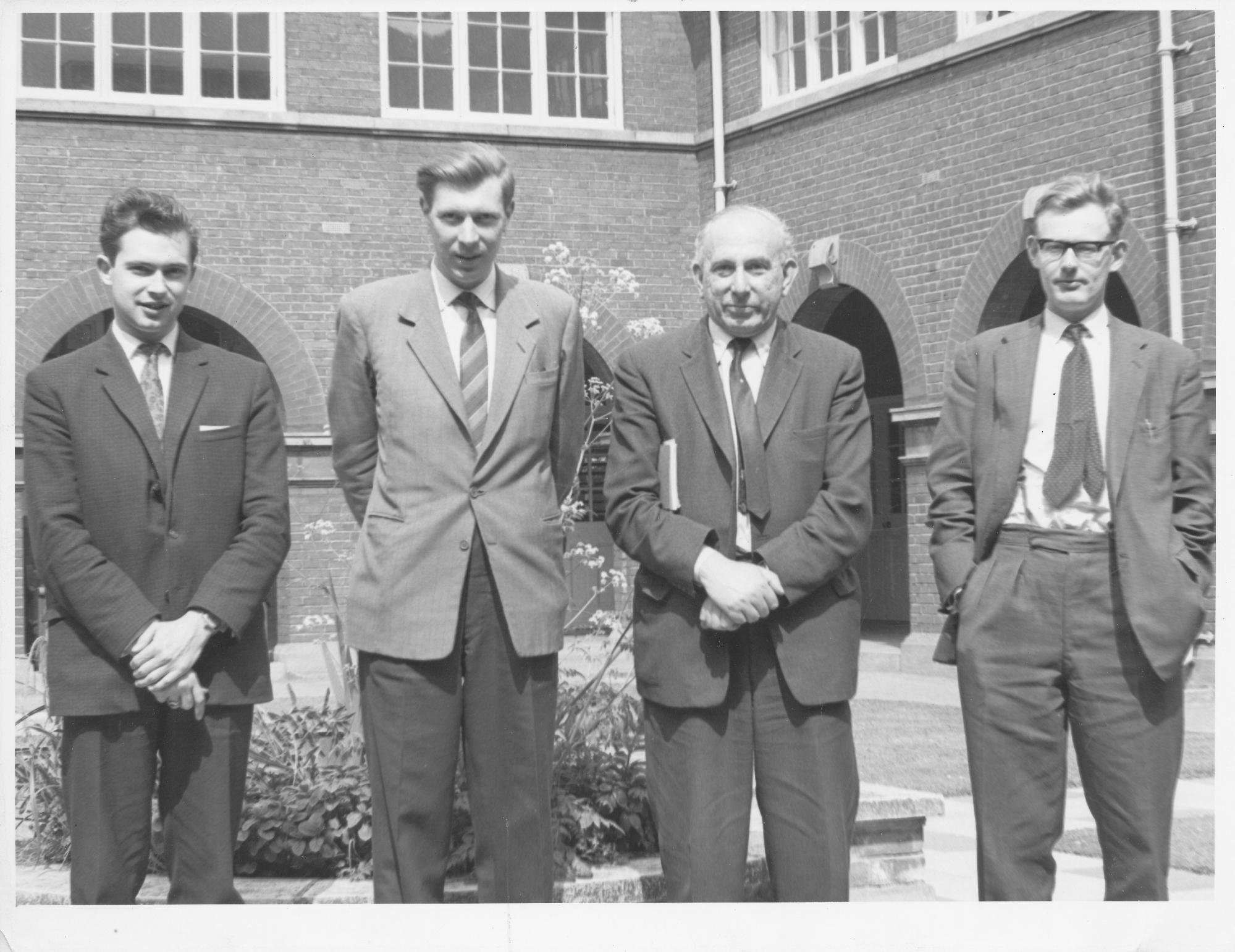
Michael played board two for London in a Telex match versus Belgrade playing Marjanovic. The game was drawn.

The Ultimate Prize : The Aaronson Masters
The Aaronson Masters at *Imperial Hotel, Russell Square, Bloomsbury, London, 1978 brought his best individual success at the age of 47, sharing first place with IM Aldo Haik of France and to boot, earning an IM norm.
(*Venue location thanks to Ken Norman)
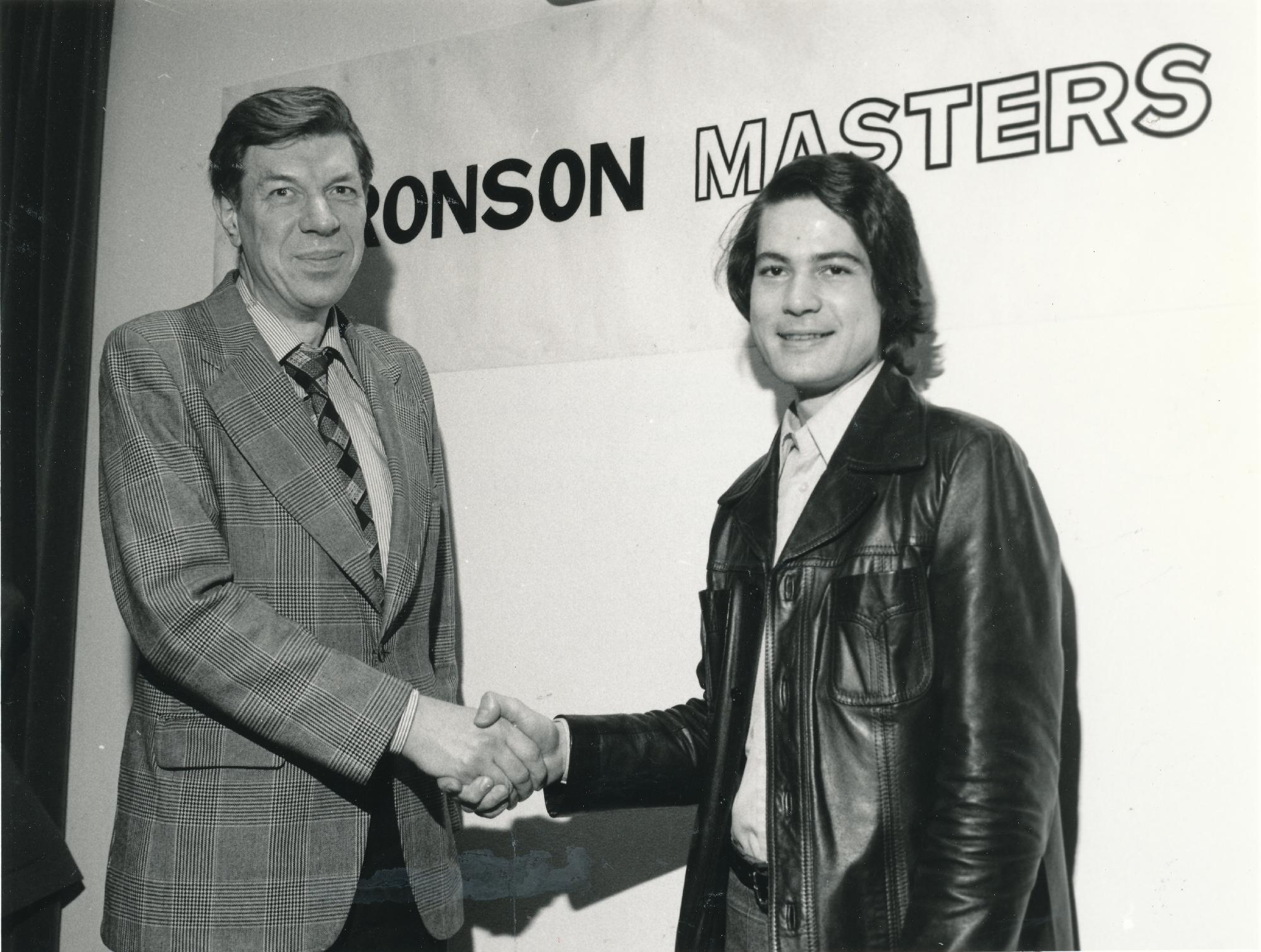
Michael scored an undefeated 7.5/10 and finished ahead of Short, Speelman, Nunn, Hartston, Mestel, Webb, Basman, Botterill and numerous other illustrious players. Michael remarked of his lifetime best result that it was
just one of those occasions when everything went right!
But he scored 3.5/5 against the IMs, was alert to every opportunity, and the games show he owed little to luck.
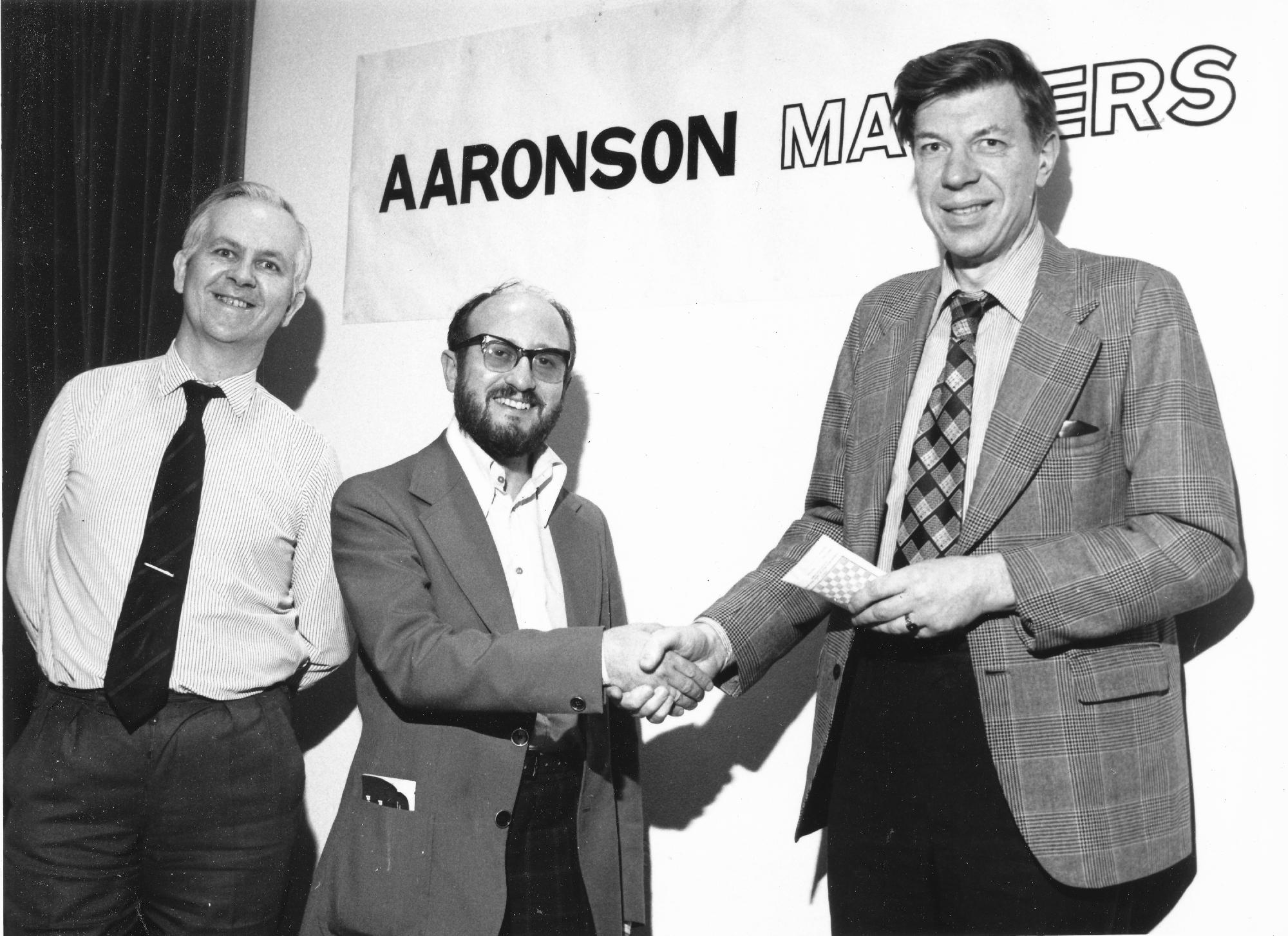
Like many others Michael made appearences in Lloyds Bank events of 1977, 1978, 1984, 1989, 1991, 1993 and 1994.
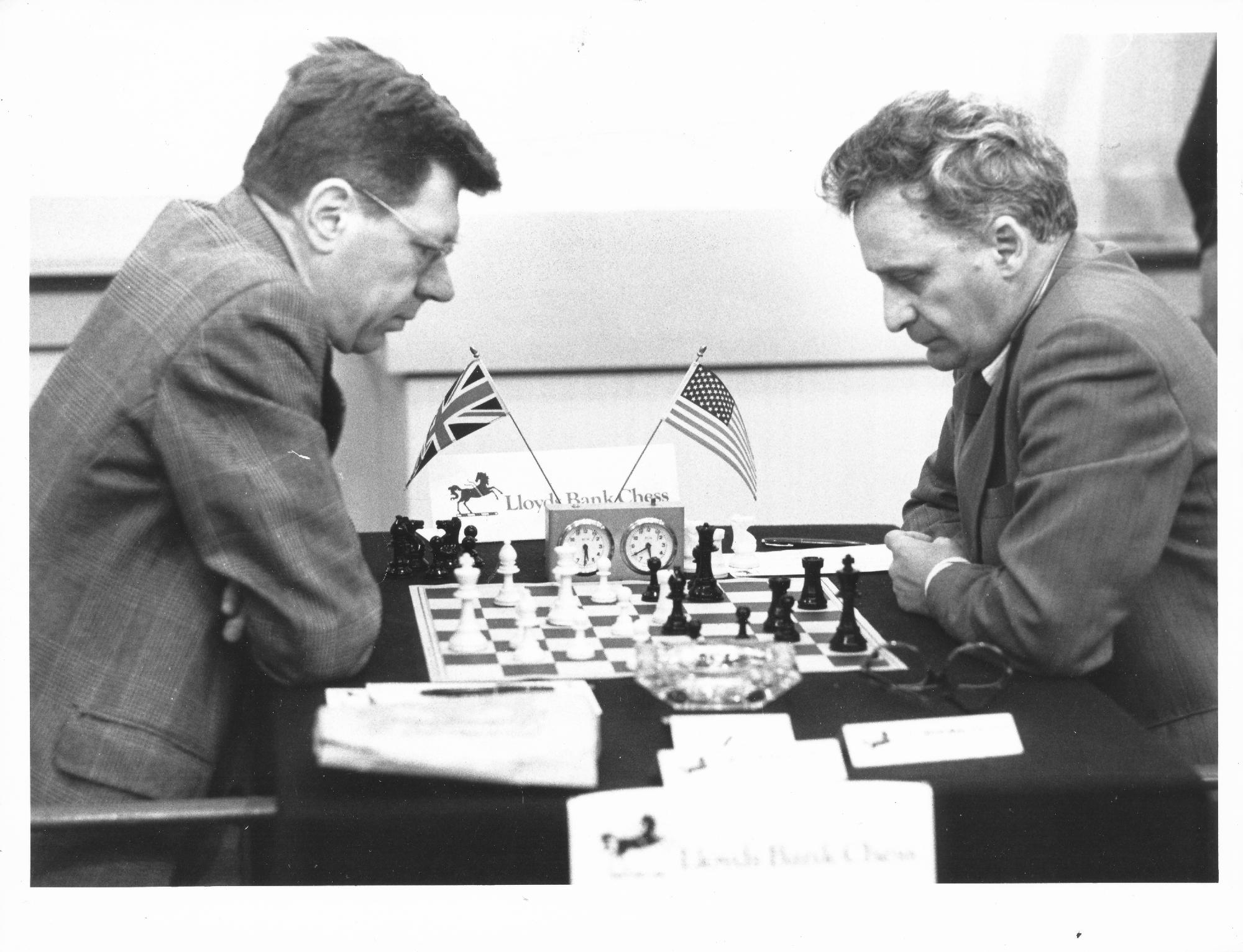
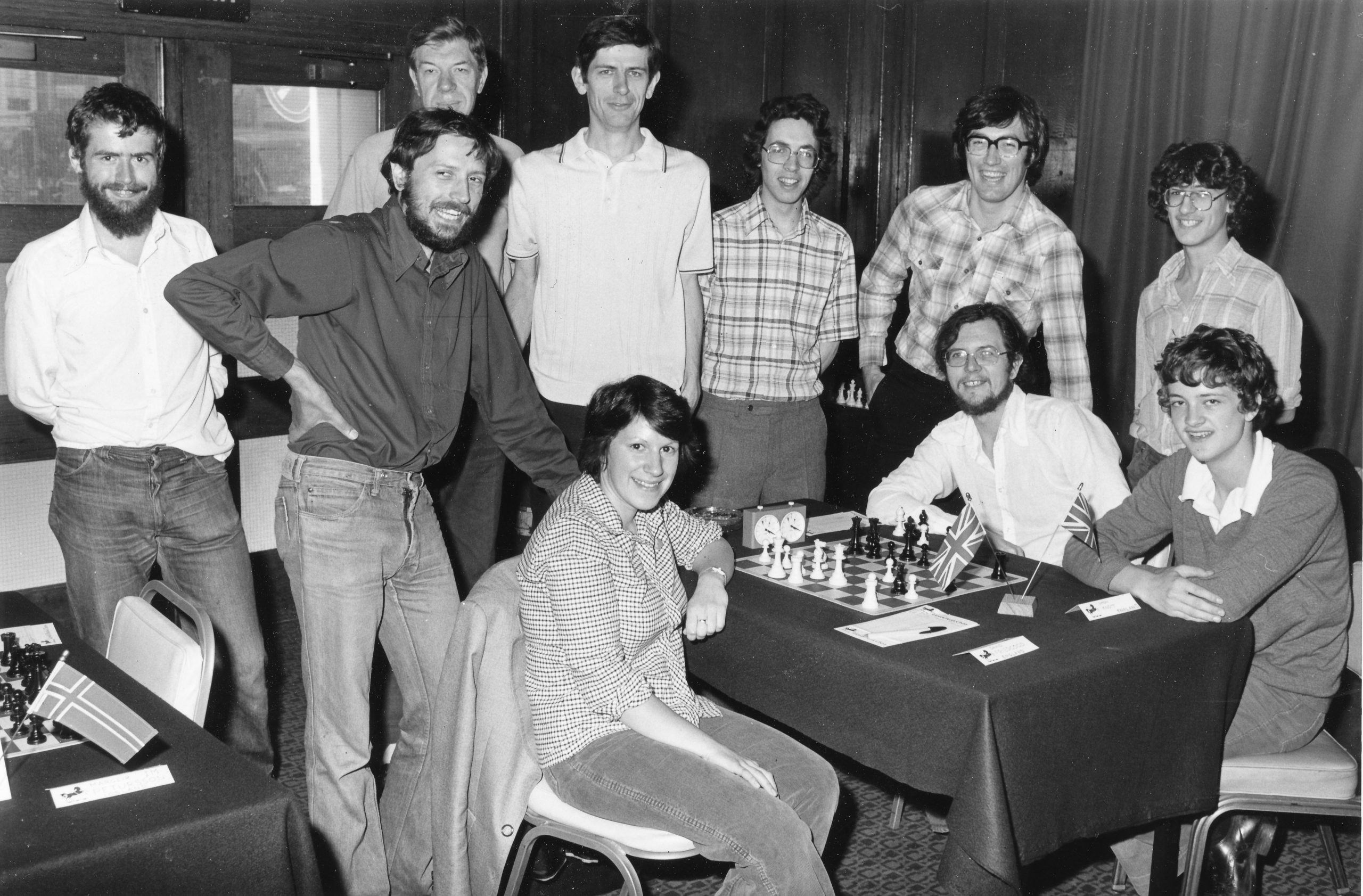
The Hastings Years
Michael first played at Hastings in 1964 when he was invited to play in the Premier Tournament. The tournament was won by Mikhail Tal and Michael finished in last place.
Undaunted he returned to Hastings in 1968 to play in the Challengers tournament. One of the attractions of playing in the Challengers was that the winner received a place the following years Premier. Frustratingly Michael finished second three years in a row! In 1968 the Challengers was won by Danny Wright, in 1969 by Martyn Corden and in 1970 by Peter Markland. Finally, in 1971 his patience was rewarded and he won the Challengers and qualified to the following years Premier.
The 47th Hastings Premier of 1971-72 had been changed from the traditional 10 player all-play-all to a 16 player tournament. Also, having obtained sponsorship from various organisations the committee were able to invite some of the top names of the day. The sponsors were:
- Jim Slater
- The Friends of Chess
- The British Chess Federation
- Bovis Holdings Ltd
- Hastings County Borough Council
So, the entry included Karpov, Korchnoi, Andersson, Najdorf, Mecking, Gligoric, Unzicker and Robert Byrne to name but a few. This was undoubtedly the strongest Hastings Premier since World War Two and possibly the strongest Hastings Tournament since 1895.
Michael started well with a draw against the Rumanian GM Ciocaltea followed by a draw in with the Brazilian prodigy Mecking. In round three he surprised everyone by beating Ray Keene. With 2/3 things were looking promising. However, after this bright start Michael only managed a draw against Unzicker and a draw with Hartston finishing in a disappointing last place with a score of 3/15.
In the tournament report Peter Clarke opined
Franklin suffered the usual fate of the gifted amateur in a professional field of simply not being accustomed to this kind of chess.
Despite this Michael continued to play in the Hastings Challengers. He played in nineteen out of the next twenty-five years! He came close to winning the tournament in 1982: he was leading the tournament with a score of 7/8 when he was informed that Jean’s Father had passed away. Having drawn his ninth round game and needing only a draw in the last round to ensure at least a tie for first place he withdrew from the tournament and immediately left for home.
The Weekend Scene
Like all players with a full time job Michael had to play most of his chess at the weekend so the explosion of weekends tournaments in the early 1970’s gave him ample opportunities. His habit of playing quickly was ideally suited to the fast time limits of the weekend tournament. During the 1970 and 1980’s he was very successful. He won numerous events and was more often than not in the prize list.
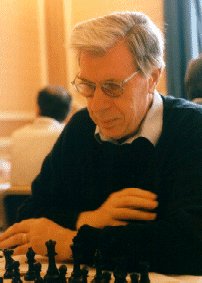
In later years he restricted himself to London based tournaments and those in the West Country. His regular tournaments being Exeter, Torquay and old favourite, Frome. Michael at the age of 78 shared first place at Frome 2009. Frome 2010 was his farewell appearance.
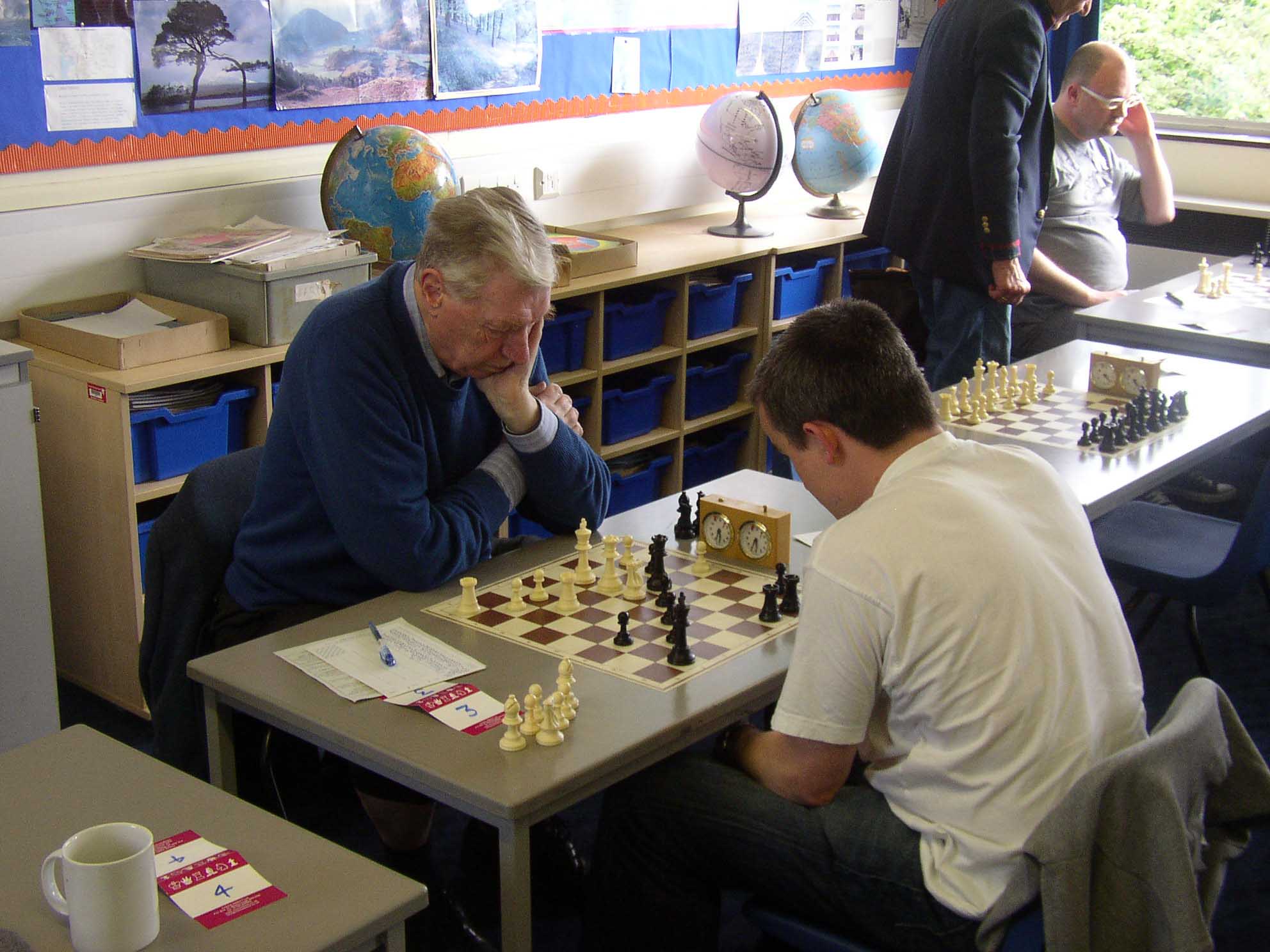
Michael played for a number of clubs viz : Richmond & Twickenham, Coulsdon CF, Surrey CCA, 4NCL Richmond, 4NCL Bristol and Richards Butler to name but a few.
Finally, in 1980, Michael was awarded the FIDE Master title and achieved his highest rating (in the Elo era) of 2345 in January 1979. It is most likely that his highest ever rating would have been more like 2450.
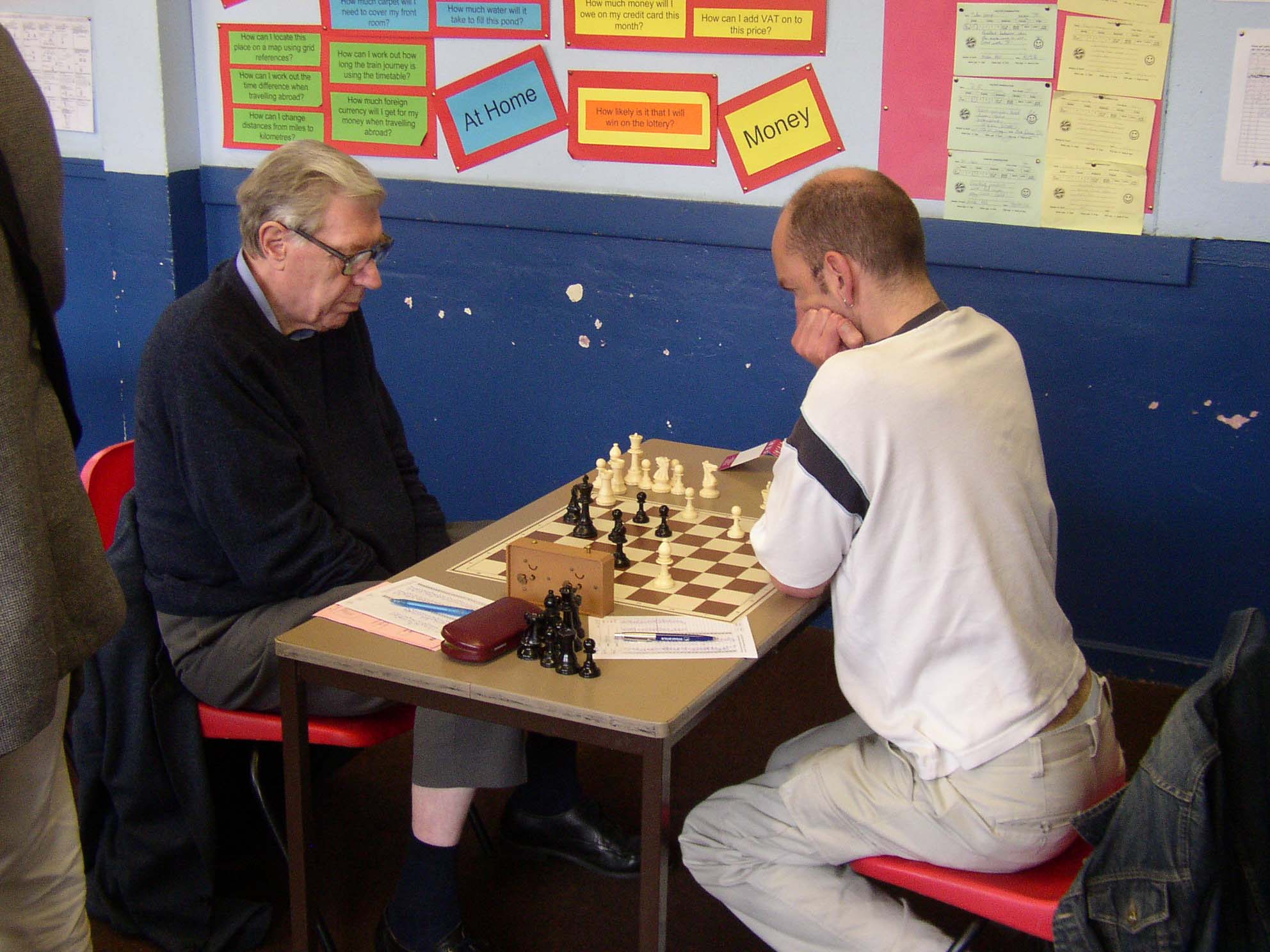
Appropriately enough Michael was the inaugural winner of the BCF/ECF Senior Prix in 2000 and won it again in 2002 and 2003. The event last ran in 2006.
When Surrey won the counties championship a few years back the team took the trophy around to Michael’s home in Norbury, such was their regard for his contributions.
The London System
Any currently active club player cannot have missed the explosive rise to prominence of the system for White he developed :
The London System and Accelerated London System has acquired a huge cohort of followers in recent times probably not realising the debt they (and many authors, book and DVD publishers!) owe to Michael. If only he could have earnt a royalty every time it was played!
Also Michael had notable success as Black with the O’Kelly Sicilian 1.e4 c5 2.Nf3 a6.
Life Outside of Chess
Michael had many interests apart from Chess. He was for many years a member of the Surrey County Cricket Club. After he retired he would arrange to meet fellow Surrey Member Frank Parr at the Oval and after lunch in the Pavilion they would spend the day enjoying the Cricket. Tennis was another sport that Michael followed. Michael was also interested in horseracing. Several players were surprised when visiting one of the racetracks around London to find Michael also attending the race meeting.
Michael was the typical “natural” player. He never studied the game and his only sources of opening information were the British Chess Magazine and the chess columns in The Times and the Guardian. He never kept the scores of his games. Once the game was finished it was time to move on. One of Michael’s greatest strengths was his optimistic attitude at the chessboard. No matter how bad the position he was confident of ultimate success.
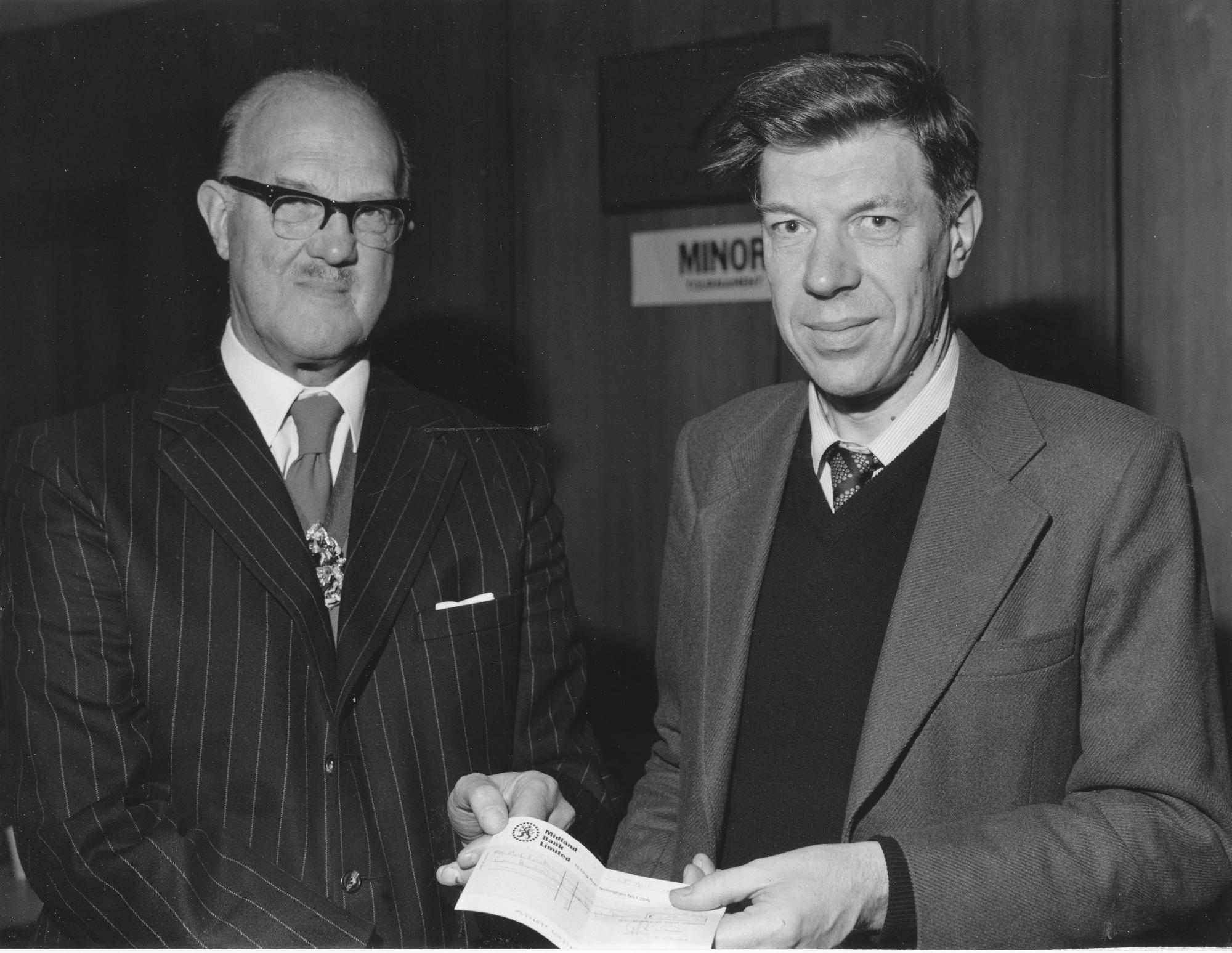
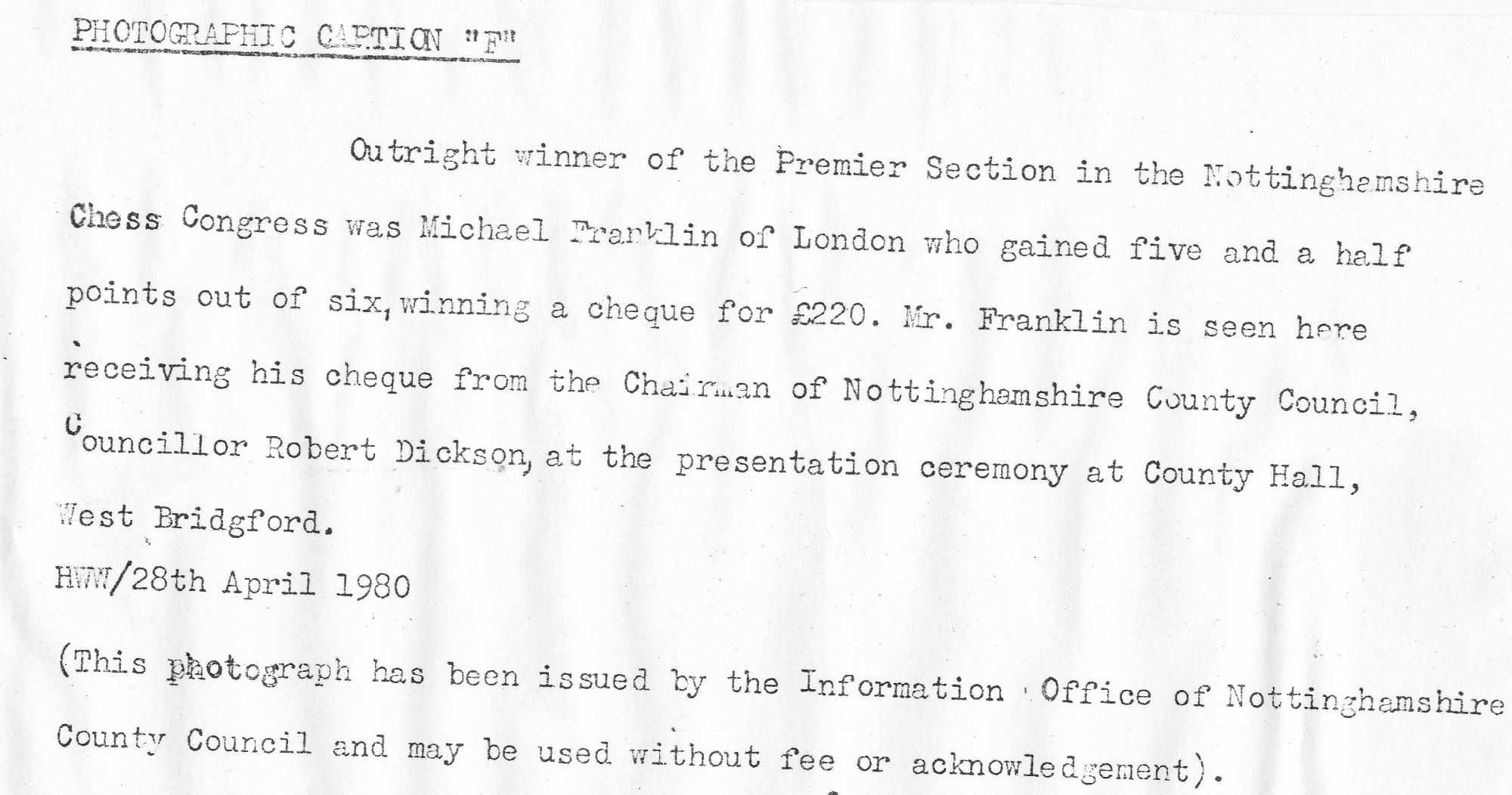
Birthday of IM Richard Pert (22-i-1981)
Birthday of GM Nick Pert (22-i-1981)
We send birthday wishes to GM Nick Pert born this day (January 22nd) in 1981.

Nick won the Southern Counties (SCCU) championship for the 2016-17 season sharing with Richard Bates.
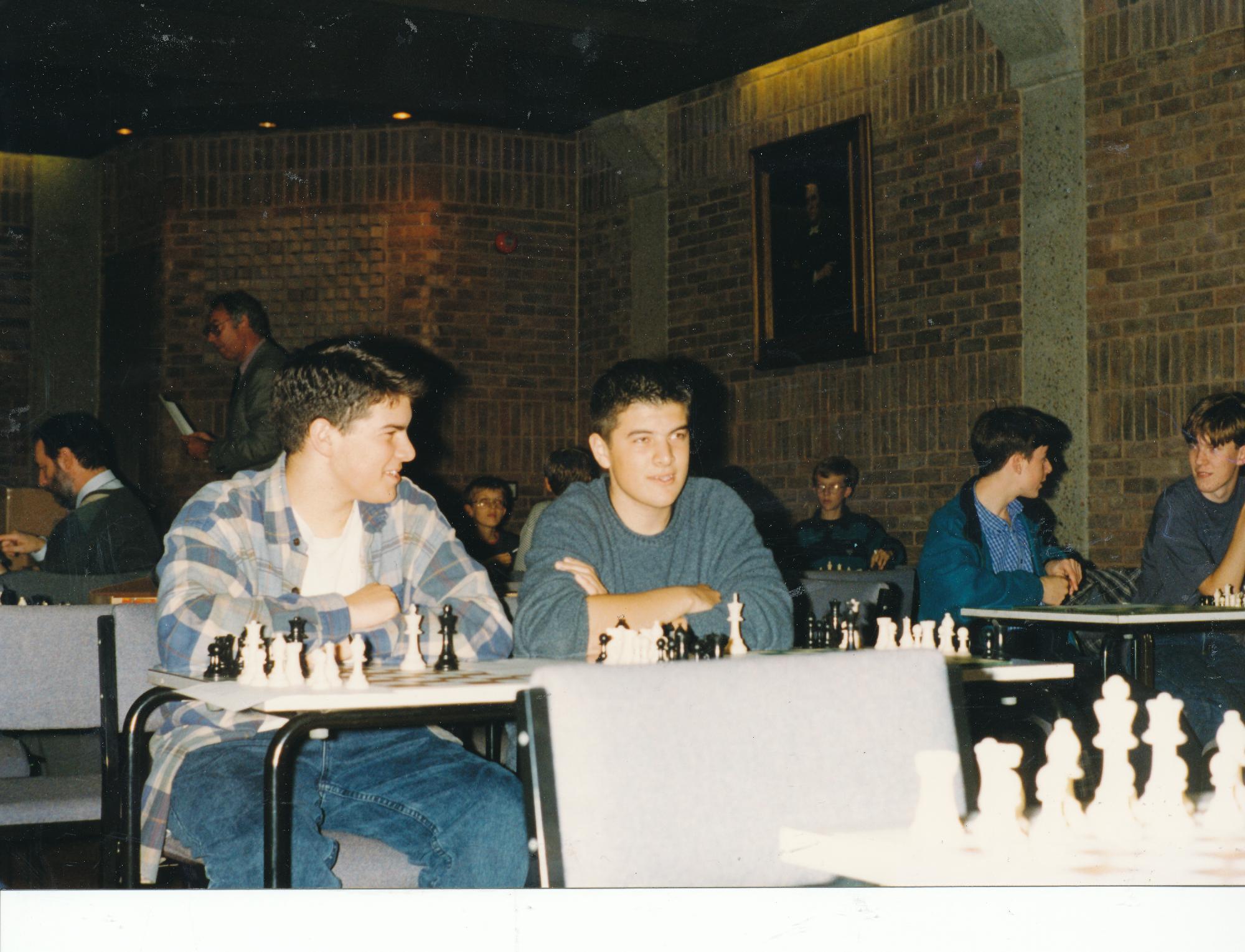
Here is Nick’s Wikipedia entry
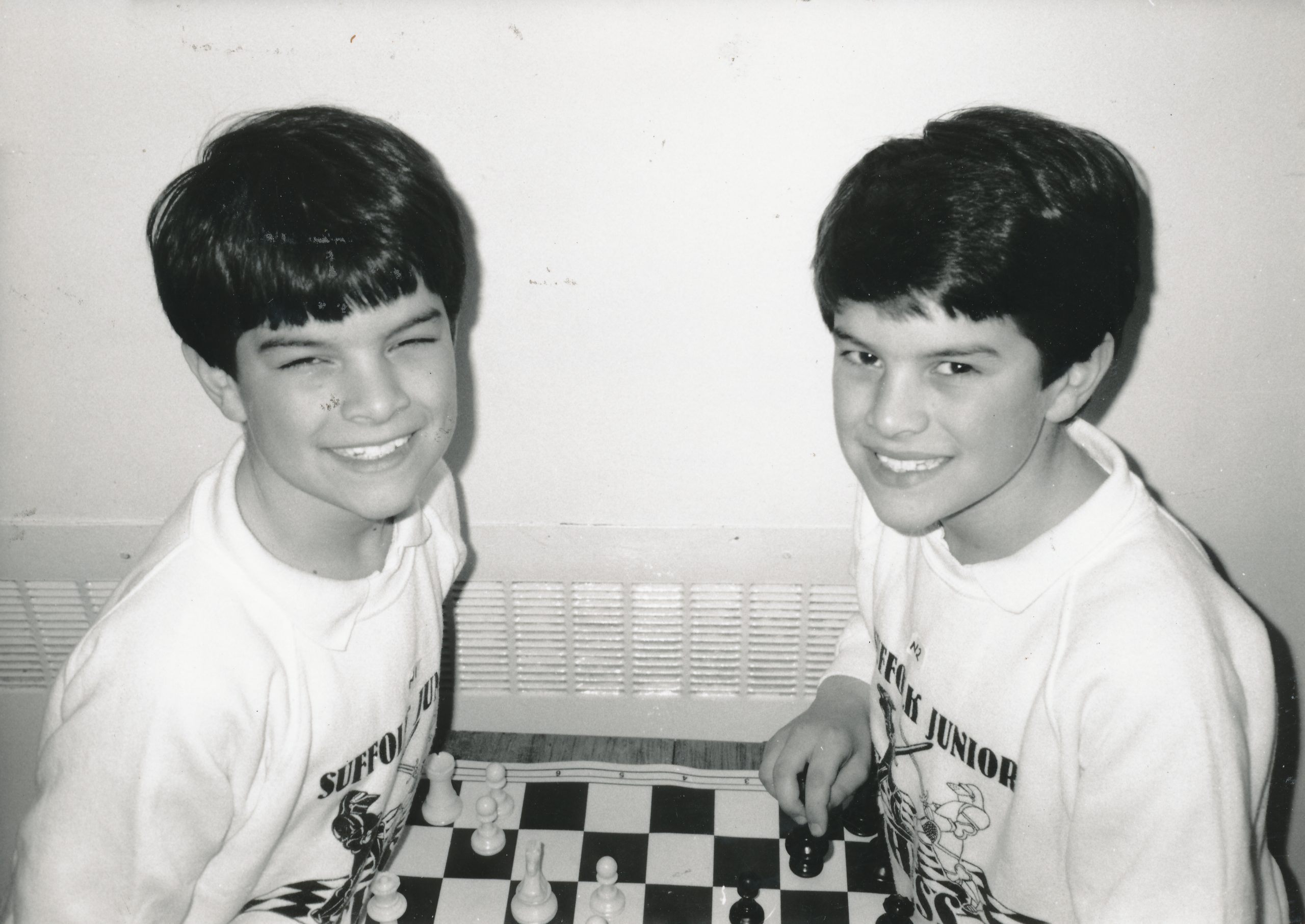
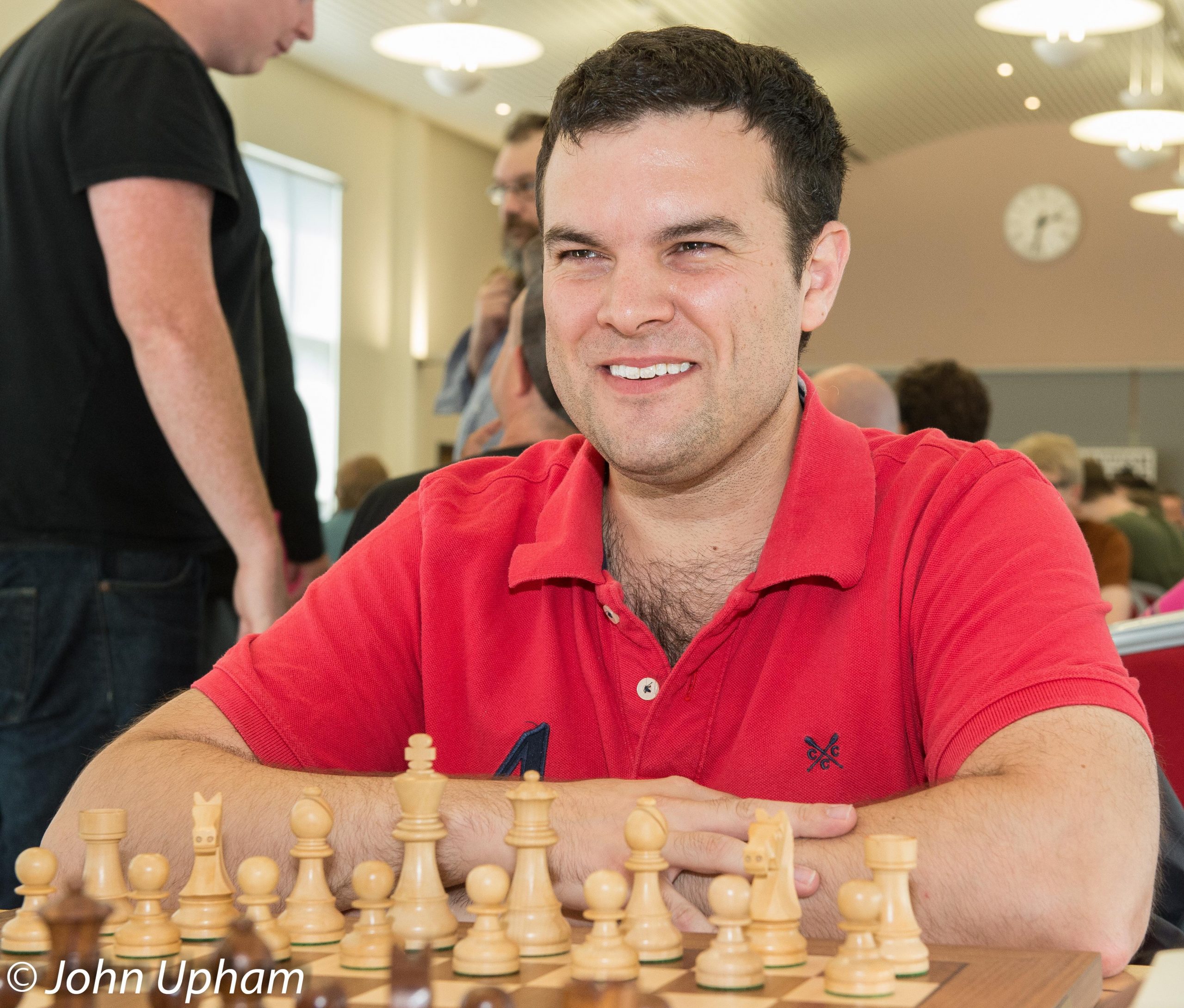
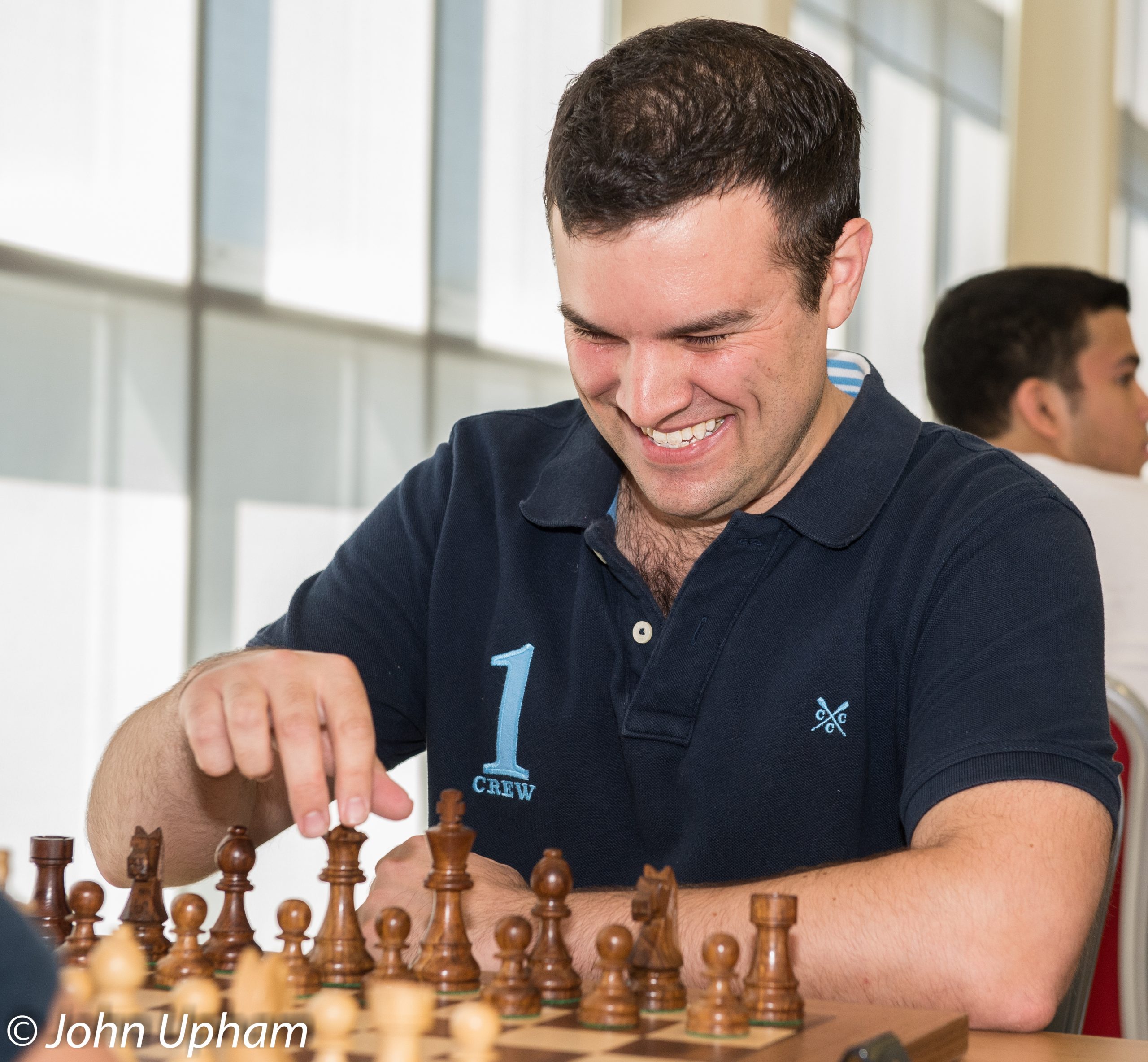
Happy Birthday IM Andrew Horton (15-i-1998)
BCN wishes Happy Birthday to IM Andrew P Horton (15-i-1998)
Andrew became a FIDE Master in 2015 and an International Master in 2018 following the 89th FIDE Congress 2018, 26 Sep – 6 Oct, Batumi, Georgia.
Andrew represents the 3Cs club in the Manchester League and in the Four Nations Chess League (4NCL) (as well as Wood Green) and, in addition, Wotton Hall, Durham City (during his University years) and Northumberland CA for county matches.
Andrew made regular appearences at the Delancey UK Chess Challenge and was placed 1st in the 2014 Terafinal, Challengers section.
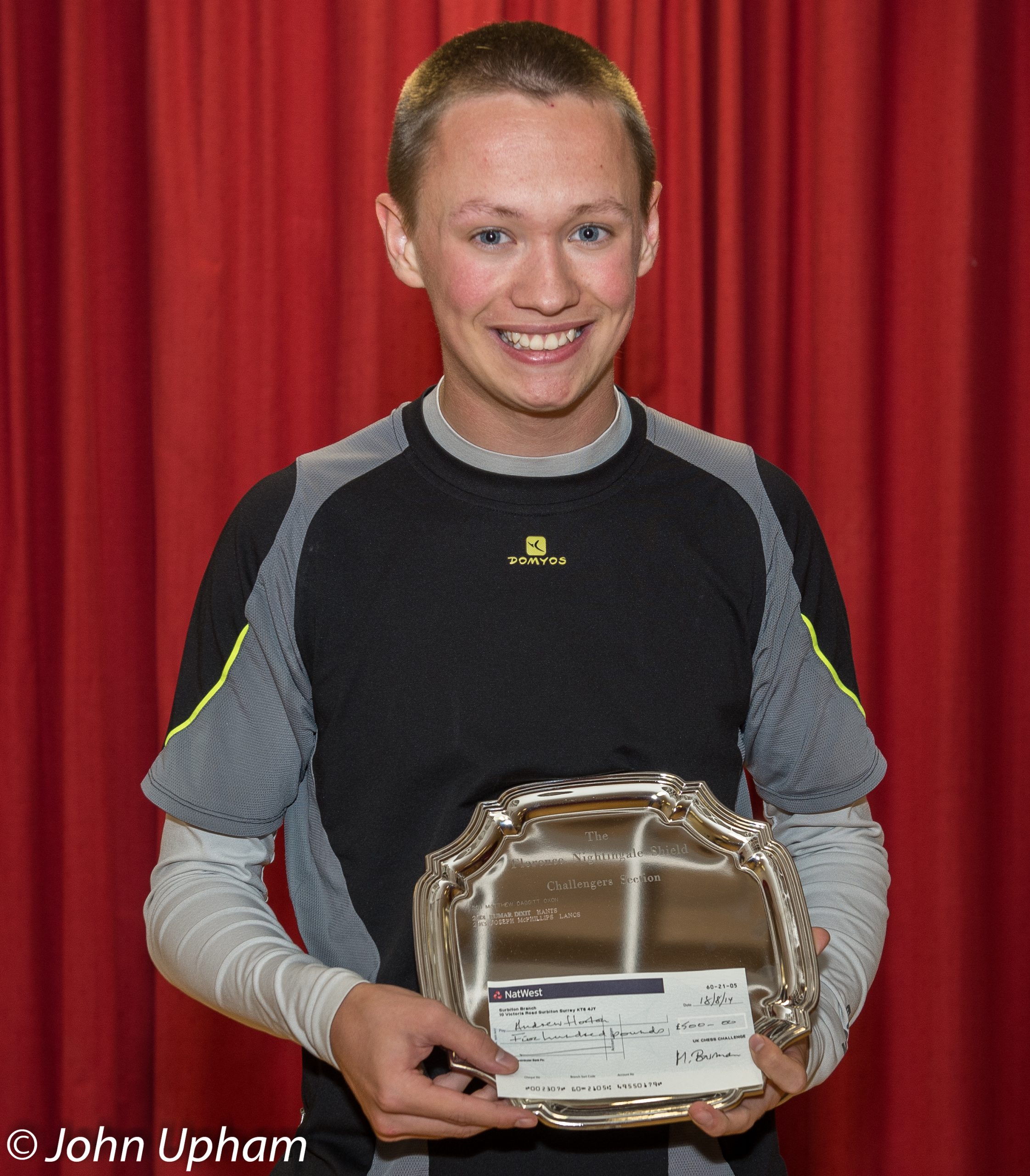
In 2021 Andrew was invited and played in the London Chess Classic at the Cavendish Conference Centre.
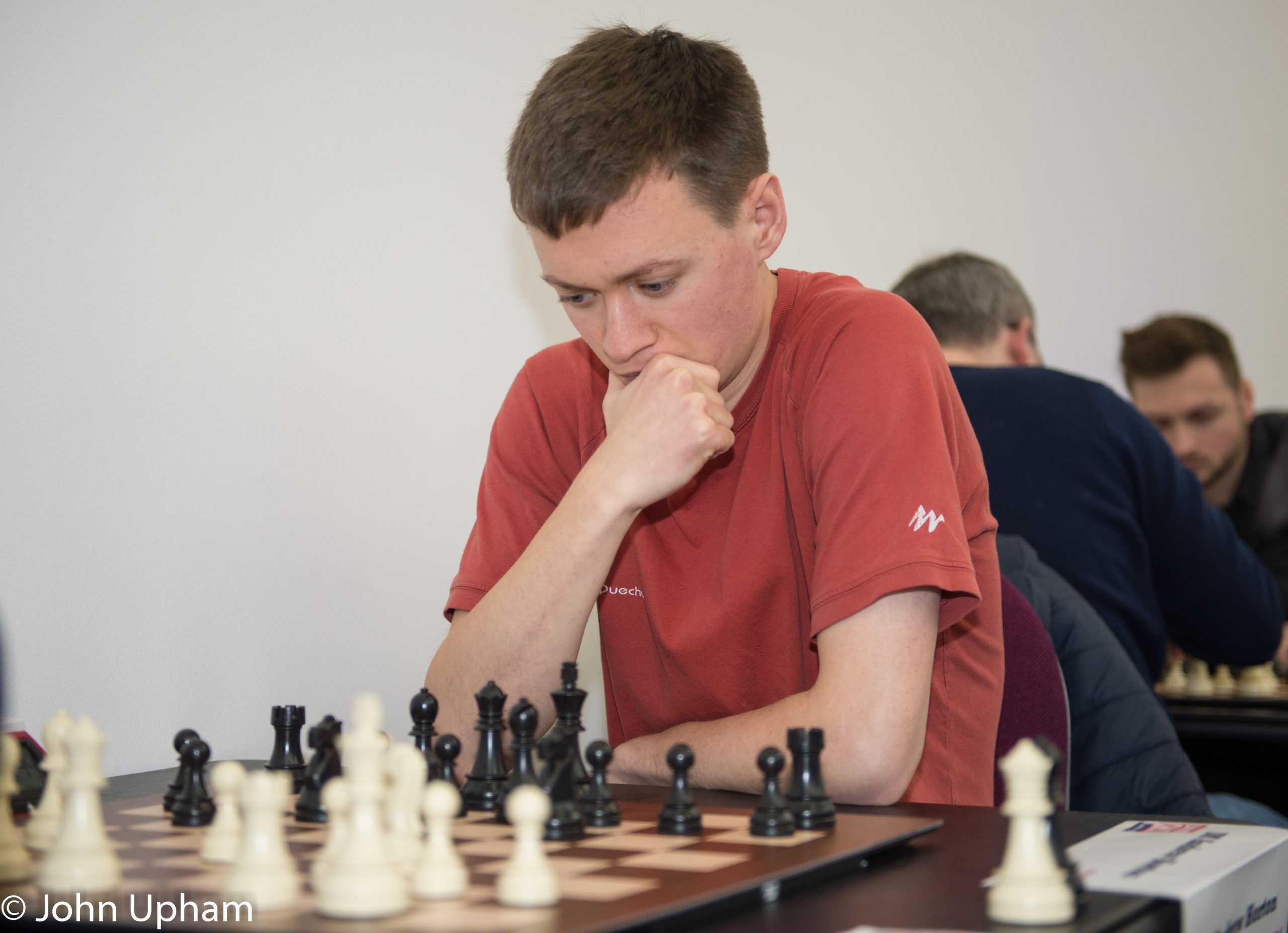
Andrew’s ECF standard play rating at January 2023 is 2452K.
Attacking Strategies for Club Players: How to Create a Deadly Attack on the Enemy King
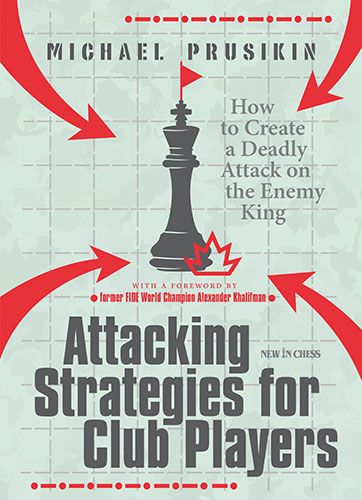
How to Create a Deadly Attack on the Enemy King, Michael Prusikin, New in Chess, 31-12-2021, ISBN-13 : 978-9056919740
From the publisher:
“Attacking your opponent’s king is not just a shortcut to victory, it’s also one of the most enjoyable and gratifying experiences in chess. If you want to win more games you should become a better attacker. Studying typical attacking motifs and ideas easily brings dividends while you are having a good time. Michael Prusikin presents the prerequisites and the rules for a King attack in a lucid and attractive manner. In 15 thematic chapters he teaches you how to assess the nature of the position, identify the appropriate offensive patterns, find the preliminary moves and conduct your attack in a clear and effective way. Battering rams, obstructive sacrifices, pawn storms, striking at the castled position, sacrificing a knight on f5, Prusikin demonstrates the most important patterns of attack with lots of clear and well chosen examples. Next, Prusikin tests your newly acquired insights and your attacking intuition with exercises covering all the themes and motifs. You will find that studying Attacking Strategies for Club Players is both entertaining and rewarding.
Michael Prusikin is an International Grandmaster and a FIDE Senior Trainer from Germany. In 2009 he was the co-winner of the German Championship. Several times he has been voted German Chess Trainer of the Year. He writes the tactics column in the German magazine SCHACH.”
In his foreword to this book, GM Alexander Khalifman explains that the subject of attack on the enemy king has been the subject of many recent books, many of which suffer from a combination of defects: lack of originality, exaggerated sensationalism, complication and subjectivity. I wouldn’t disagree in principle, but who doesn’t love any book featuring ferocious attacks, brilliant combinations and beautiful sacrifices? Khalifman believes this book is different because it explains how to set up an attack.
Here’s what Prusikin has to say in his introduction:
… the theme of this book is not basic attacking motifs. I assume you are already familiar with these or I would recommend that, if so inclined, you read the classic The Art of Attack by Vladimir Vukovic or its modern counterpart Essential Chess Sacrifices by David LeMoir. In this book we shall address the strategic requirements for a successful attack on the king and some lesser-known attacking motifs, though no less relevant in practice. I hope this will be both interesting and useful for players with an Elo rating between 1500 and 2300.
Chapter 1 is just two pages long. We learn the prerequisites for successfully attacking the king: lead in development/uncastled opposing king, space advantage in the vicinity of the opposing king, few defensive pieces near the opposing king, and weakened pawn protection. Then we have some tips for carrying out a successful attack: use all your pieces, open lines, don’t be afraid to sacrifice and don’t waste time.
Chapters 2 to 16 each feature a different attacking idea, with some brief instructions and some examples from play.
Chapter 2: King in the centre.
Here’s an extract from a game which particularly impressed Prusikin, between a 17-year-old Egyptian and a higher-rated 16-year-old Iranian (Fawzy – Maghsoodloo Abu Dhabi 2017).
16. Nb5!!
An astonishing sacrifice, the idea of which doesn’t reveal itself until you have seen White’s 19th move.
16… axb5 17. axb5 Qb7 18. Rxa8+ Qxa8
And now what? Why has White actually given up the piece?
19. f5!!
The next hammer blow, a left-right combination in boxing parlance.
19… Nxe5
A) 19… gxf5 20. Qh5 +-
B) 19… exf5 20. e6! +-
C) 19… Bxe5 20. fxe6 fxe6 21. Nf7+-
20. fxe6 f6 21. Bxe5 fxe5 22. Rf7 Bf8 23. Nxh7
23. Qf1 Bc5+ 24. Kh1 Ne7 25. b6 Qc6 26. Qf6! Rg8 27. Rxe7+ Bxe7 28. Qf7+ Kd8 29. Qxg8+ Qe8 30. Nf7++– was the alternative solution.
23… Bc5+ 24. Kh1 Ne7
Fawzy would have had to demonstrate similar, perhaps even more beautiful motifs after the defensive move 24… Be7 25. b6! Kd8 (25… Nh6 26. Nf6+ Bxf6 27. b7 Qb8 28. Qxd5 Nxf7 29. Qd7+ Kf8 30. Qxf7#) 26. Qf1 Nh6 27. Qb5 Qb7 28. Rf1!! (Wonderful geometry: the rook swings to the a-file!) 28…Rxh7 29.Ra1 Bf8 30.Ra7 Nf5 31.Rxb7 Rxb7 32.Qxd5+ Nd6 33.Qc5 and White wins.
25. Qf1!!
Threatens 26. Rf8+ but at the same time ‘eyes up’ b5 – the queen in all her glory!
25… Nf5 26. b6!! Qc6 27. b7 Ba7 28. Qxf5+!
Not the only way to win, but certainly the most spectacular and at the same time the most convincing solution!#
28… gxf5 29. Nf6+ Kd8 30. e7+
Black resigned
What a game! The modern-day ‘Immortal’!
(A few comments on this extract: 1) I’ve omitted a couple of diagrams from the book 2) Prusikin doesn’t mention that Black could have held the position by playing 17… Rxa1, which he might have found had he foreseen 19. f5! and 3) if you have MegaBase you’ll find the same annotations (in German) there.)
Chapter 3: Obstructive sacrifice: a sacrifice to impede your opponent’s development: for instance White playing a pawn to e6.
Chapter 4: Attacking the king without the queen: attacks in queenless middlegames or even in endings.
Chapter 5: Pawn storm with opposite-side castling.
Chapter 6: Pawn storm with same-side castling.
Chapter 7: Using the h-pawn against a fianchetto.
I was very struck by this miniature: Gomez Sanchez – Otero Acosta (Santa Clara 2017). I’ll pick up the game with Black about to play his 9th move in this very typical Réti Opening.
8… h5!
The first game of this chapter, Steinitz – Mongredien, was probably the first time that the fianchetto, rather unusual at the time, had been attacked in such a daring way. Here too, the Steinitz attack seems to pose considerable problems for the Réti set-up.
9. d3
(There’s a long note here, concluding that 9. cxd5 is probably White’s best move here, which I’ll omit from this review.)
9… h4 10. Nxh4?
The beginning of the end. Once again, the only feasible defence was to open the centre: 10. cxd5! exd5 11. e4, although even here White would have had some difficult practical problems to solve, for example: 11… hxg3 12. hxg3 d4!? 13. Ne2 Qa5! with the idea of switching to h5. Black gets a dangerous attack.
10… Rxh4! 11. gxh4 Nh5 12. Qe1?
The final mistake. 12. f4 Nxf4 13. Qe1 would still have offered resistance, although Black would have had a clear advantage.
12… Bf3!!
Blocks the f-pawn; 12… Qh4? 13. f4.
13. Bc1 Qxh4 14. h3 Nf4 15. Bxf3 Qxh3 0-1
I suppose Prusikin might have mentioned that the idea behind Black’s 12th move is well known from, for example, a famous Fischer – Benko game.
Chapter 8: Using the g-pawn to destroy your opponent’s king protection.
Chapter 9: The nail in the coffin: a pawn on f6 or h6 in front of an opposing castled king.
Chapter 10: Doubled g-pawns, which can be used as an attacking weapon, or, on the other hand, can weaken the king’s defence.
Chapter 11: Using pieces to attack the castled position.
Chapter 12: The Grand Prix Attack: attacking a king behind a fianchettoed bishop with f4-f5, Qe1-h4, Bh6 etc.
Chapter 13: The knight on f5: sacrificing a knight on this square where it can be captured by a pawn on g6.
Chapter 14: Long bishop on b2: how a fianchettoed queen’s bishop can help your kingside attack.
This example is taken from Zsuzsa Polgar – Chiburdanidze (Calva Ol W 2004)
Here we join the game at its culmination: the dark-squared battery is already set up, the g-pawn has chased away the knight on f6 and with her last move … g7-g6 Black has carelessly weakened the long dark diagonal. In spite of all this, achieving the said culmination is anything but easy.
14. Nxe5!! Nxe2!
Was the Georgian former World Champion relying on this counter-attack?
A) 14… Qe7 15. Be4!! dxe5 16. 16. Bxb7 Nxe2! 17. Kxe2 Qxb7 18. Qxe5 f6 19. Qe6+ Qf7 20. Qxf7+ Rxf7 21. Bxf6+-
B) 14… dxe5 15. Qxe5 f6 16. Qxf4 gxf5 17. gxf6+ +-
15. Nxf7!!
If the first knight move was obvious, now comes the real ‘hammer blow’!
After 15. Kxe2? dxe5 16. Bc2 (16. Qxe5?? Re8) 16… Nc6 the advantage would have switched to Black.
15… Nxc3 16. Nh6+ Kg7 17. Bxc3+ Rf6 18. Bxf6+ Qxf6 19. gxf6+ Kxh6 20. Be6+-
Black could have resigned here but struggled on until move 39.
Chapter 15: Interference: specifically here playing a minor piece to the opponent’s back rank to block out an opposing rook.
Chapter 16: Breakthrough on the strong point: sacrificing on a square which appears to be very well defended.
At the end we have the seemingly obligatory quiz: 50 puzzles for you to solve. While some involve finishing off your attack, others require you to find a plan to put your attack in motion. You’re not told which is which.
You’ll see from the extracts above that, at one level, this is a lovely book crammed full of dashing attacks on the enemy king and beautiful sacrificial play. The expertly annotated examples are conveniently grouped by theme and with some helpful snippets of advice on how to identify when an attack of this nature would be appropriate, and how to carry it out.
As such it will, as the author suggests, appeal to anyone from, say, 1500 to 2300 strength. The themes won’t be new to stronger and more experienced players but they’ll still benefit from seeing them in action. While the author points out that the explanations at the start of each chapter are short to allow more space for games, they sometimes seemed rather perfunctory to me.
I’m also not sure that the book is entirely free from the flaws Khalifman has noted in other volumes of this nature. Yes, it’s a bit different from other books in the way it’s organised, and, while many of the games, including quite a few from Prusikin’s own games, were new to me, there were also some frequently anthologised chestnuts.
I’m also not convinced that the book is free from exaggerated sensationalism. The annotations, and sometimes the exclamation marks, perhaps tend towards the hyperbolic. As Khalifman rightly points out, ‘you don’t learn anything abut physics or chemistry by watching a fireworks display’, but the examples do tend to be firework displays rather than the more mundane attacks that are more likely to occur in your games.
It’s a large and complex subject, and, to do it full justice based on 21st century chess knowledge, you really need 400 or 500 pages rather than the 192 pages we have here.
The book was originally published in German and has been competently translated by Royce Parker, so the language problems sometimes apparent in books from this publisher don’t arise here. The production standards are high, and there’s a refreshing lack of typos.
It’s an entertaining and instructive book which will be enjoyed by a wide range of readers, but is it an essential purchase? Probably not.
Richard James, Twickenham 9th June 2022

Book Details:
- Softcover: 192 pages
- Publisher: New In Chess (31 Dec 2021)
- Language: English
- ISBN-10:9056919741
- ISBN-13:978-9056919740
- Product Dimensions: 17.02 x 23.11 cm
Official web site of New in Chess

How to Create a Deadly Attack on the Enemy King, Michael Prusikin, New in Chess, 31-12-2021, ISBN-13 : 978-9056919740
Remembering IMC Ken Messere OBE (16-iv-1928 31-iii-2005)
BCN remembers Ken Messere who passed away on Thursday, March 31st 2005 aged 76 in Paris-16E-Arrondissement, Paris, France.
Kenneth Charles Messere was born on Monday, April 16th, 1928 in Richmond-on-Thames, Surrey. His father was Charles (George) Messere (1901-1974) or Eisenberg and aged 26. His mother was Gertrude Marie Newman (1899-1978) and aged 29.
Ken had three siblings: Barbara Marie Messere (1930–2005), Hugh Martin Messere (1932–1985) and Derek R Messere (1934–2012)
Ken attended St. Peter’s College, Oxford from 1946 – 1951 to read philosophy and is reported in the 1951 St. Edmund Hall Magazine, as a member of the Trillick (debating) Society as follows:
‘ That this House would rather be a live Communist than
a dead Democrat.’ The proposer established to his own satisfaction that democracy was founded on ‘selfishness, capitalism and bourgeois hypocrisy.’ He did not satisfy J. F. R. Bonguard of St. Peter’s Hall who opposed, using arguments taken from Hindu philosophy. K. C. Messere of St. Peter’s Hall, spoke third and added some able arguments.
In June 1954 Ken married Mary Elizabeth Humphrey (1929-2003) in Ealing. They had a son Miles Jonathan Messere born in 1964 who passed away in 1965.
Prior the time of his passing his wife Mary was living at 142B, Herbert Road, Woolwich, London, SE18 3PU.
In 1991 he was awarded the OBE (Civil Division) in the Queen’s Birthday honours list. The citation reads: Kenneth Charles Messere, lately Head of Fiscal Affairs Division, OECD, Paris.
Ken appears each year from 1953 to 1967 in the noted publication Britain, Royal And Imperial Calendars the function of which is to list entries for those engaged in UK public service. He worked for HM Customs and Excise. Prompted by this we consulted the venerable A History of Chess in the English Civil Service by Kevin Thurlow (Conrad Press, 2021) on page 447 and found
“He played for Customs. In 1964, he went to work for the Organisation for Economic Cooperation and Development and was head of fiscal affairs from 1971 – 1991. In 1954 he began playing postal chess and became a leading player. He won a semi-final of the 5th World Correspondence Championship (1961 – 64) and became the first English player to compete in a World Championship Final.”
There are 31 games listed at his personal entry at chessgames.com starting with games from 1965.
Chessbase’s Correspondence Database 2020 records 69 games the earliest being from 1958 listing Ken’s federation as being France.
From British Chess (Pergamon Press, 1983) we have this lengthy contribution from Ken himself:
“Between the ages of 6, when I learnt to play and 23 (ed: 1951), when I ceased to be a student, chess had a relatively low priority among various time-competing interests and activities, so I never got around to studying theory. Things changed when I became a civil servant and needed a replacement for philosophy as an intellectually absorbing subject which could be argued about with friends over beers, and for the next 12 years chess became my main interest.
Since 1964 I have been working for the OECD in Paris, where my friends are not chess enthusiasts and, although chess remains a major pleasure, my commitment to it has lessened. Nowadays, out-side correspondence chess, I play only occasional blitz games.
Coming late to serious chess has probably had at least some influence on my deficiencies and stylistic preferences. The deficiencies include an inability to visualize ahead with sufficient clarity to support accurate analysis, slow sight of the board which leads to silly errors through time trouble or failing stamina and less familiarity with theory than my better opponents. As to chess style, I have had to play romantically and subjectively to get good results.
If a game takes the form of a clear-cut position, where strategical objectives are clear and superior technique prevails, then mine generally does not. Consequently I have tended to play either sharp gambits or counter-gambits or to try to render the position sufficiently obscure for imagination and intuition to assume maximum importance. In keeping, my chess heroes have been Alekhine, Bronstein and Tal who revel in fantasy, however much Alekhine may claim that it is logically based.
When I took up competitive chess seriously in 1952, I made some progress and won a few minor tournaments, but in view of the defects already mentioned, it soon became clear that my potential for improvement was limited and that nearly all my games were aesthetically flawed. Fortunately, these defects represent no great handicap at correspondence chess, where I found myself pleased with a reasonable proportion of the game I played, and in addition, capable on the day (or more accurately over the years) of winning against almost anyone. Thus, against world champions I have two wins and one loss, (see below). I also have 80 per cent from five games against Russian grandmasters, even if a meagre 28 per cent from my eighteen games against all correspondence grandmasters. In 1954 when I began playing postal chess competitively, I did sufficiently well in a few British Postal tournaments to be accepted at a reasonably high level in the official international tournaments.
Not without luck (see Diagram l), I secured the 75 per cent necessary in two seven-player tournaments to qualify for the fourteen player preliminaries, the winner of which was to qualify for the following world championship. In the 1961-64 preliminaries, I played the best chess of my life, including valid opening innovations, imaginative pawn and piece sacrifices and even a technically efficient win in a queen and pawn end-game. I won the tournament with eleven wins, one draw and one loss, 1.5 points ahead of Maly of Czechoslovakia and two points ahead of Masseev, the Russian favourite, thereby obtaining my first norm towards the International Master title. My first annotated game is the win against Maly (ed: to be inserted once we have tracked down the game score!) which was typical stylistically and also crucial, since if he had won it, he would have qualified for the World Championship instead of me: the second against Bartha of the United States is the most compulsive and difficult tactical game I have ever played, the last five moves alone requiring over 100 hours of analysis.
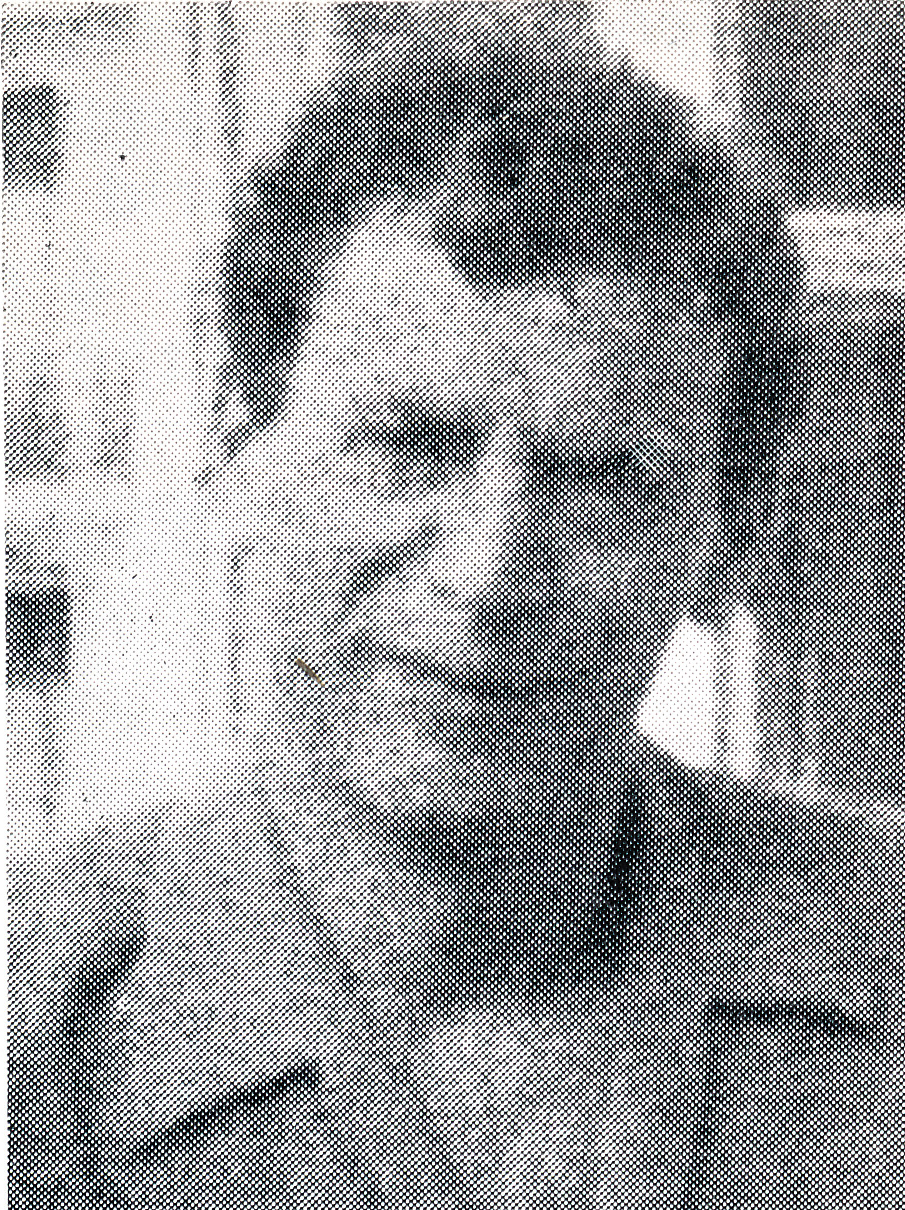
The quality of my chess in the 1965-68 World Championship was much inferior. The tournament began disastrously. I went in for three losing variations as Black and made a suicidal clerical error in the opening so that after 3 months I had four losses from four games. Later, there were compensations. I won against V. Zagarovsky, the reigning world champion (the third annotated game) and obtained just (but only just) the necessary 33.3% per cent to obtain the correspondence chess international master title. For this I needed a win and draw from my last two games which
after 3.5 years, had to be adjudicated.
Fortunately, the win and draw were relatively clear, though this would not have been so a few moves earlier. An an illustration of how the threat of adjudication breeds irrationality, Diagram II gives the closing stages of my win against J.Estrin of the USSR – a more recent correspondence chess world champion. My only other game against a world champion was against the winner of this tournament, Hans Berliner of the United States, with whom I collaborated on a book of the tournament. The collaboration was stimulating but not without friction, since I had to write 75 per cent of the book to see it ever finished. It took a year to complete, 3 years to appear (published by BCM) but in the end was well-reviewed, sold over 2000 copies and royalties are still (gently) drifting in.
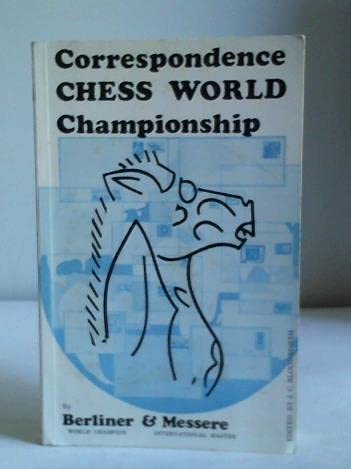
In the early seventies, in order to reduce numbers of games, I retreated altogether from individual tournaments, just playing twice for England in the Olympiads. Whether team play did not suit my style, or whether my technique had improved but imagination withered, I drew nine of my seventeen games from the two tournaments, winning four and losing four. As England looked likely to aspire to medals for the first time ever, my 50 per cent would not help matters and I gladly retreated to first reserve, which to my dismay required taking over five unfinished games of Hugh Alexander, who died during the tournament, and who, for me, has always been England’s most attractive player and writer. My most uncomfortable decision in correspondence chess was a rejection of Hugh’s intended continuation in one of these games, {Diagram III). Of these five games, I lost one and drew four and England won a bronze medal.
In 1974 was invited to compete in the Potter Memorial Tournament of four postal grandmasters and nine international masters. After so many years of responsible’ team chess for England, I went beserk and sacrificed a pawn in ten of the twelve games, trying later to salvage inferior end-games. Result 33 % per cent. B. H. Wood invited me to write a book of the tournament, to which a number of the players contributed and this was published in 1979.
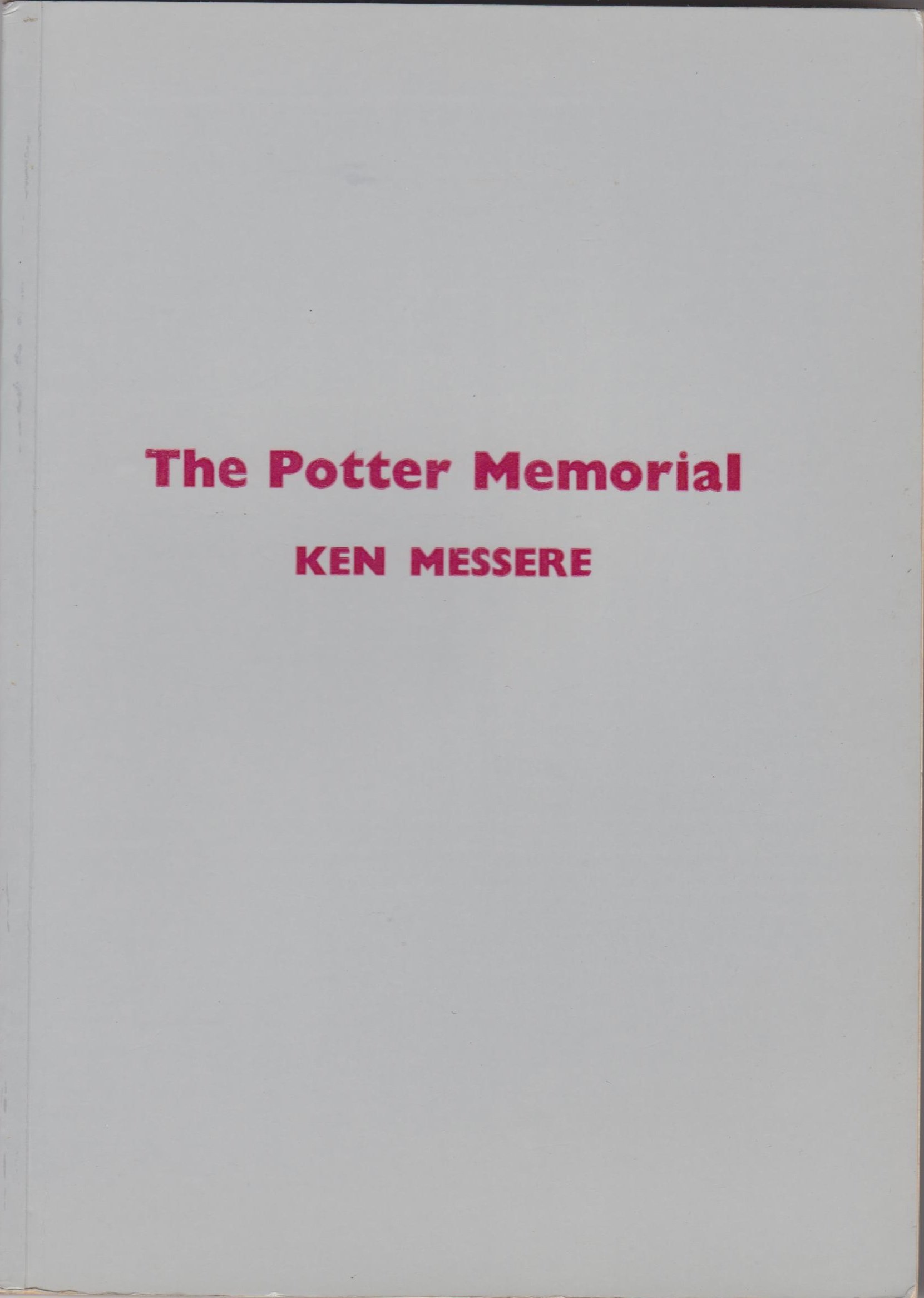
Also in 1979 I began to play in another invitation tournament of thirteen players organised by the Australian Correspondence Chess League, which became a memorial to CJS Purdy, its president and the first world postal champion, who died soon after the tournament began. At the time of writing, this tournament, comprising four grandmasters (including one former world champion and two runners-up) and eight international masters, is still in its early stages.”
From British Chess Magazine, Volume CXXV (125, 2005), Number 5 (May), page 226 we have this obituary:
“Kenneth Charles Messere (16 iv 1928, Richmond – 31 iii 2005, Paris) was one of Britain’s strongest correspondence players (he held the correspondence IM title) and well-known author of books on the subject. After graduating from Oxford University, Ken Messere went to HM Customs and Excise, and thence to the Organisation for Economic Development (OECD) where he became head of the fiscal affairs division and a world expert on fiscal law. He reached the final of 1965-8 world correspondence championship, beating world champions Zagorovsky and Estrin, and wrote the book of the tournament with Hans Berliner (published by BCM)”
From The Potter Memorial by Ken Messere, CHESS (Sutton Coldfield), “Chess for Modern Times” Series, 1975 we have this potted biography:
“Compiler of this book, took 3rd place in 1957 and 2nd in 1968 in the championship of the Postal Chess Club. Scores of 4.5 out of 6 in the ICCF Masters 1957-8 and 4/6 in the 1959-61 Championship took him to victory with 11/5 out of 13 in the 1961-3 semi-finals, securing him his first international master norm and qualifying him for the 5th World Championship 1964-7 in which he scored 5.5, just enough for the IM title, with wins over Zagorovsky, then world champion and Estrin, world champion now. Ken Messere collaborated with Berliner, who won it, in a book on the tournament.
He then switched to play exclusively as a member of the British Olympiad team, taking over 2nd board when Alexander died.
The switch back from rather cautious team play to enterprising individual games in 1974-7 provides some of the subject matter of this book.”
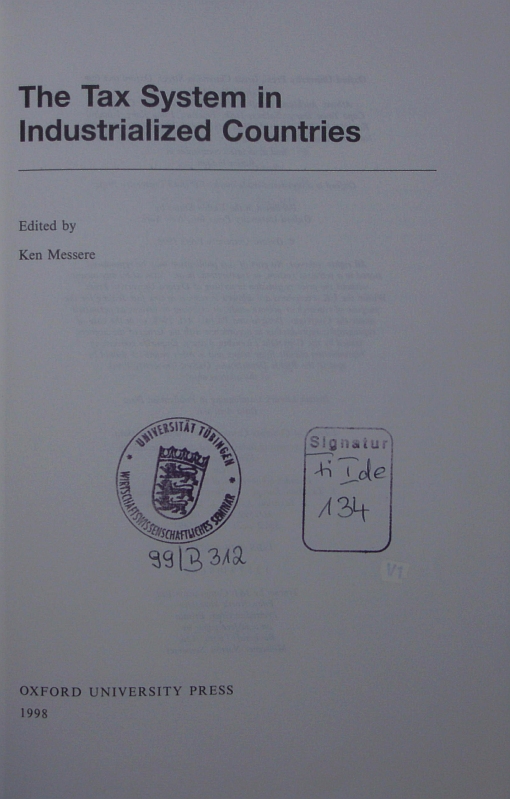
Mastering Chess Logic
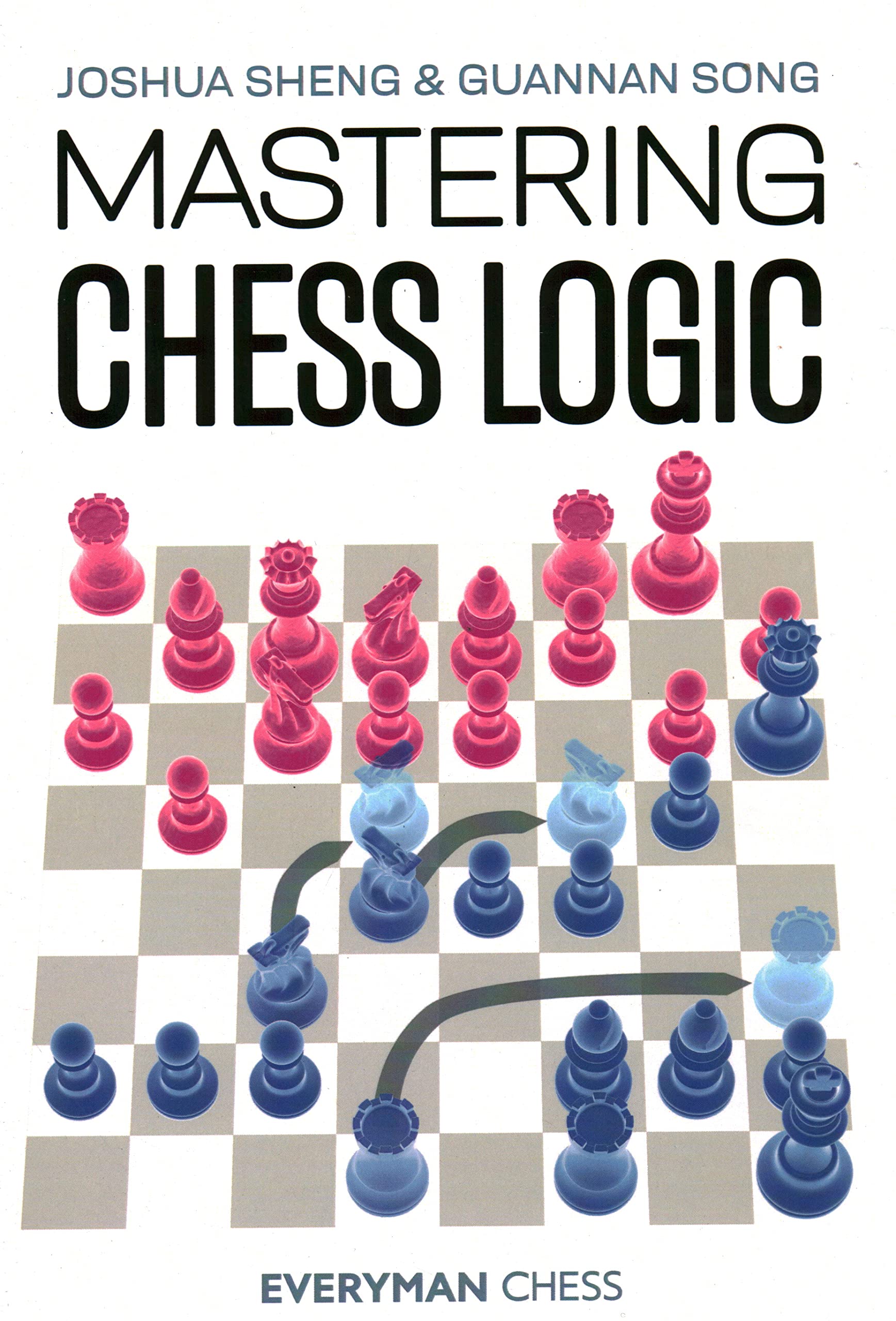
Here is the publishers blurb from the rear cover :
“What exactly makes the greatest players of all time, such as Magnus Carlsen, Bobby Fischer, and Garry Kasparov stand out from the rest? The basic aspects of chess (calculation, study of opening theory, and technical endgame ability) are of course of great importance. However, the more mysterious part of chess ability lies within the thought process.”
In particular: * How does one evaluate certain moves to be better than others? * How does one improve their feel of the game? This book will tackle this woefully underexplored aspect of chess: the logic behind the game. It will explain how chess works at a fundamental level. Topics include:
- What to think about when evaluating a position.
- How to formulate and execute plans.
- How to generate and make use of the initiative.
The reader also has plenty of opportunities to test their decision-making by attempting 270 practical exercises. These are mostly designed to develop understanding, as the justification of the moves is more important than the actual correct answer.”
and about the authors :
Guannan Song is a FIDE Master with one International Master norm from Canada. He won the 2010 Canadian Youth Chess Championship and scored bronze at the 2015 North American Junior Chess Championships. He also played for Team Canada at the 2010 World Youth Chess Championship and the 2014 World Youth U16 Chess Olympiad. He represents Western University on board 1 of its Championship team and led his team to 2nd place at the 2019 Canadian University Chess Championship.
Joshua Sheng Joshua Sheng is an International Master with one Grandmaster norm from Santa Monica, California. He tied for first in the 2016 North American Junior Chess Championships and placed third in the 2019 U.S. Junior Chess Championships. He graduated from the University of California, Berkeley, in 2021. Joshua has been a serious chess coach for many years, and this is his first book.
As with every recent Everyman Chess publication high quality paper is used and the printing is clear. Each diagram is clear as is the instructional text. Figurine algebraic notation is used throughout and the diagrams are placed adjacent to the relevant text.
The book consists of six chapters viz:
- Building Blocks
- Know What You Have
- Mise en Place
- The Big Game
- Beginning and End
- Solutions
A video review has appeared on YouTube.
Before going further you may Look Inside via Amazon.
The authors might not be very well known to you, so perhaps we should find out more.
The publishers tell us that ‘Joshua has been a serious chess coach for many years’ and that ‘Guannan is an experienced chess coach’. But according to FIDE Joshua was born in 2000 and Guannan in 1998. They haven’t been alive many years, let alone been serious chess coaches for many years. Some of us have been teaching chess (although in my case not very seriously) since 1972. Not only before they were born, but perhaps even before their parents were born.
Let’s give them the benefit of the doubt and take a look inside.
From the authors’ introduction:
This book will be arranged primarily into sections where games will be analysed and your authors will talk. The talking and exposition will predominantly be done in the first person to ease communication. The beliefs and opinions held will generally be shared by both authors, although the primary voice will be Joshua’s. At the end of each of the first four chapters, there will be 30 practical exercises intending to reinforce your understanding of the relevant topics. Chapter 5 will consist of another 150 exercises representing a more comprehensive synthesis of the explored material and are designed to test your overall knowledge and understanding. For the most part, we have intentionally avoided mentioning the end result or the game continuation after the point of interest from those exercises, as doing so might distract the reader from the primary point of them – developing your understanding. What matters is the decision-making process at the critical position shown in each puzzle.
What we have here is a book aimed mainly, I would say, at players between about 1500 and 2000 strength, although many of the puzzles demonstrate much stronger players making poor decisions.
It’s relatively easy, I suppose, to write books about openings, tactics or endings, but strategy, being a rather nebulous topic, is much harder to write about.
Other recent books, for example those by Erik Kislik, have discussed logic in chess, but these have, for the most part, been aimed at higher rated players.
There have been other books looking at strategy at this level – an excellent and much quoted example is Michael Stean’s book Simple Chess. The authors have also used Jeremy Silman’s rightly popular How to Reassess your Chess and make frequent references to imbalances in their explanatory material. These days we’re very much into interactive learning, so we expect quizzes to be incorporated so that we can test our understanding of the book’s content.
This book, then, looks like it fills a gap in the market as an interactive instructional book on logic and strategy for club standard players.
The first chapter, Building Blocks, introduces the reader to some basic concepts: material (including compensation), piece activity, piece improvement, pawn structure and space. In each case a few simple examples are provided, which are aimed more at 1500 than 2000 rated players.
Then, we move onto some quiz questions to test your understanding. All the puzzle positions in this book have been taken from games played between 2019 and 2021, so it’s very unlikely that you’ll have seen many – or any – of them before.
Here’s the first question, with Black to play (Arabidze – Jojua, Tblisi 2019). What would you recommend?
The answer (in part):
20… Bh6!
Black finds a great opportunity to force a trade of dark-squared bishops, getting rid of his weak blunted piece on g7 and its strong counterpart on e3. A lax move like 20… Ke7? would lose the opportunity to trade bishops after 21. Bf2.
Of course you also have to see that Bxc4 fails tactically. There’s an assumption throughout the book that you have a reasonable level of tactical ability.
Chapter 2, Know What You Have, looks at positional evaluations. The authors use the acronym MAPS (Material, Activity, Pawn structure and king Safety) to lead you to your desired destination. This is taught by means of four games. We have Botvinnik – Capablanca (Netherlands 1938), which, if you’ve read a lot of chess books, you’ll have seen many times before, followed by Geller – Euwe (Zurich 1953), which again you may well have seen on many previous occasions. The chapter concludes with two recent games played by Joshua Sheng.
In Q35 (Grinberg – Ipatov, chess.com 2021) it’s again Black’s move.
In this instance Black got it wrong.
17… Be5?
Black protects his d6-pawn but gives away his two-bishop advantage. 17… Re6! was a greatly superior way to continue. A subsequent …Qe8 would place insurmountable pressure on e4. After 18. Rbd1 Qe8 19. Qb3 b5 20. Bxd6 c4 Black retains the bishop pair, recovers the pawn on the next move, and maintains pressure on White’s position.
Chapter 3, Mise En Scene, talks about identifying candidate moves, using a combination of calculation and evaluation. So they’re been reading Kotov as well as Silman, then? This time we have five example games: three from Sheng, plus Fischer – Spassky 1972 Game 6 (like Botvinnik – Capablanca, one of the most anthologised games of all time) and Tal – Rantanen from 1979.
In Chapter 4, The Big Game, we look at the initiative. The games are Kasparov – Andersson from 1981, Hydra – Ponomariov from 2005, and another three from Sheng.
Here’s one of them. (Click on any move for a pop-up window.)
Chapter 5 offers the reader 150 puzzles based on the lessons from earlier in the book.
Here’s another question: Q243 (Wall – Greet, Dublin 2019). It’s Black’s move again.
This is yet another question to do with trading bishops. Here, Richmond top board IM Gavin Wall chose to trade off his bad bishop, but this time he was mistaken.
19. Bc1?
At a glance, White holds a space advantage and control over the c-file. However, with this move, White starts to remove important defenders from his d4-pawn, giving Black a way back into the game. Though it looks like White is trading away a bad bishop for Black’s good bishop, the white bishop on b2 is actually a strong defensive piece. Better was 19. Bd3!, preparing h3-g4 or Nc3-Bxf5-Nxd5.
There’s a lot to admire about this book. There are very few books of this nature on the market providing interactive strategic instruction for club level players. As a 1900-2000 player myself I thought it was pitched at the right level for me, and would be accessible, if challenging, for ambitious and hard-working players from, say, 1500 upwards. The positions have been expertly chosen and the solutions are well explained giving just the right level of detail.
Having said that, introducing Chapters 2-4 through a seemingly fairly random selection of games (a combination of old chestnuts which many readers will have seen before and games by one of the authors) is not the only way to approach this topic. A different approach would have been to provide more specific advice and demonstrate some worked examples with more detailed explanations of thought processes before moving onto the quiz questions.
Again, another approach to questioning which would make the book more suitable for 1500 strength players (but perhaps less suitable for 2000 strength players) would have been to ask leading questions or provide multiple choices rather than just asking you for the next move.
The authors write engagingly and annotate well: I look forward to reading more from them in the future. If the concept appeals, and you think from the examples that it’s written at the right level for you, this book can be warmly recommended. As usual from Everyman, the publishing standards are exemplary.
Richard James, Twickenham 18th January 2022

Book Details :
- Paperback : 256 pages
- Publisher: Everyman Chess (10 Sept. 2021)
- Language: English
- ISBN-10: 178194623X
- ISBN-13: 978-1781946237
- Product Dimensions: 17.15 x 1.5 x 24.18 cm
Official web site of Everyman Chess

Death Anniversary of GM Dr. Jonathan Penrose OBE (07-x-1933 30-xi-2021)
BCN remembers GM Dr. Jonathan Penrose OBE who passed away on Tuesday, November 30th 2021.
In the 1971 New Years Honours List Jonathan was made an Officer of the Order of the British Empire (OBE) The citation read “For services to Chess.”
From British Chess (Pergamon Press, 1983) by Botterill, Levy, Rice and Richardson : (article by George Botterill)
“Penrose is one of the outstanding figures of British chess. Yet many who meet him may not realize this just because he is one of the quietest and most modest of men. Throughout the late 1950s and the whole of the 1960s he stood head and shoulders above any of his contemporaries.
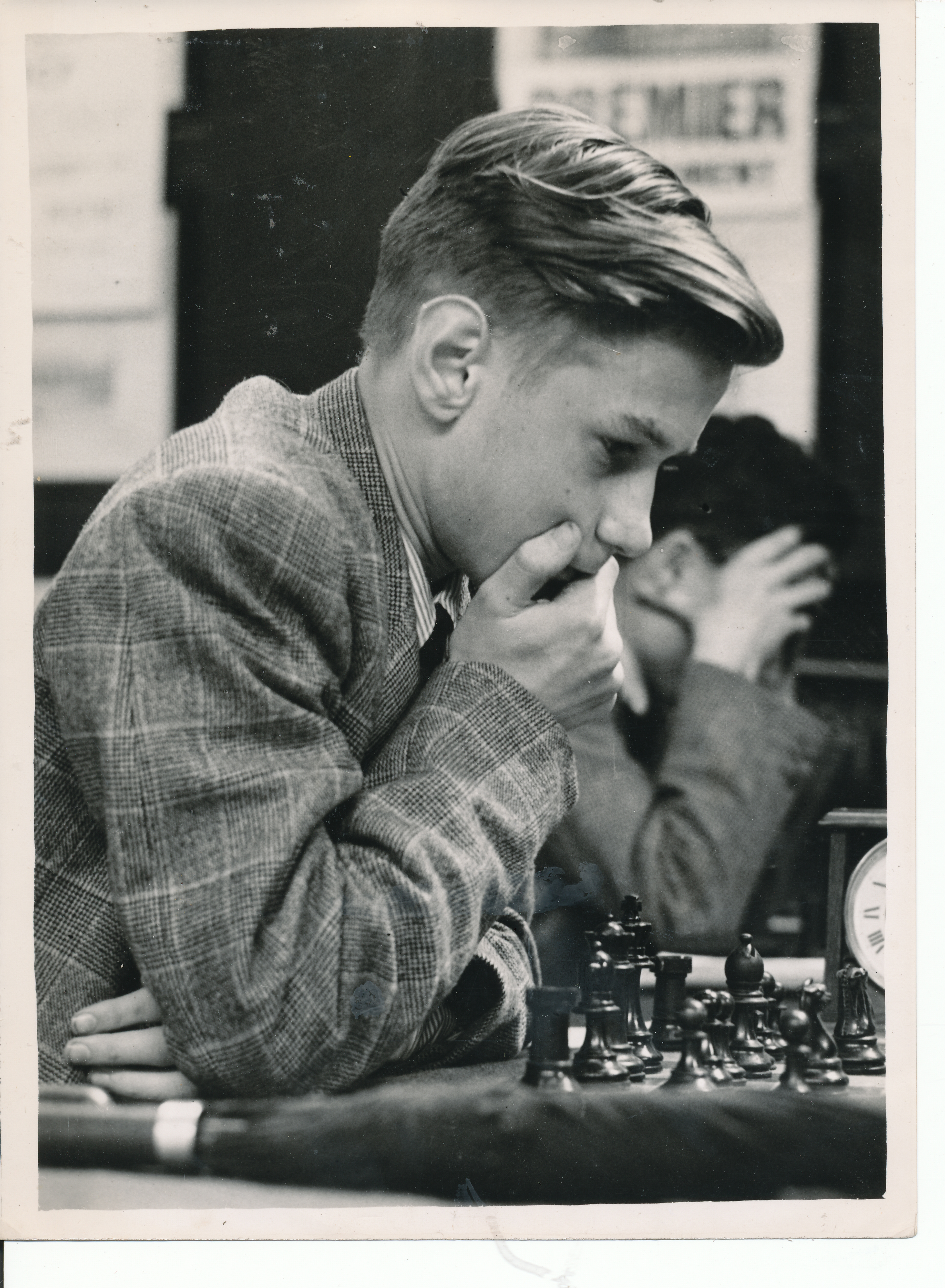

His extraordinary dominance is revealed by the fact that he won the British championship no less than ten times (1958-63 and 1966-69, inclusive), a record that nobody is likely to equal in the future.
At his best his play was lucid, positionally correct, energetic and tactically acute. None the less, there is a ‘Penrose problem’: was he a ‘Good Thing’for British chess? The trouble was that whilst this highly talented player eff0ectively crushed any opposition at
home, he showed little initiative in flying the flag abroad. There is a wide-spread and justifiable conviction that only lack of ambition in the sphere of international chess can explain why he did not secure the GM title during his active over-the-board playing career.

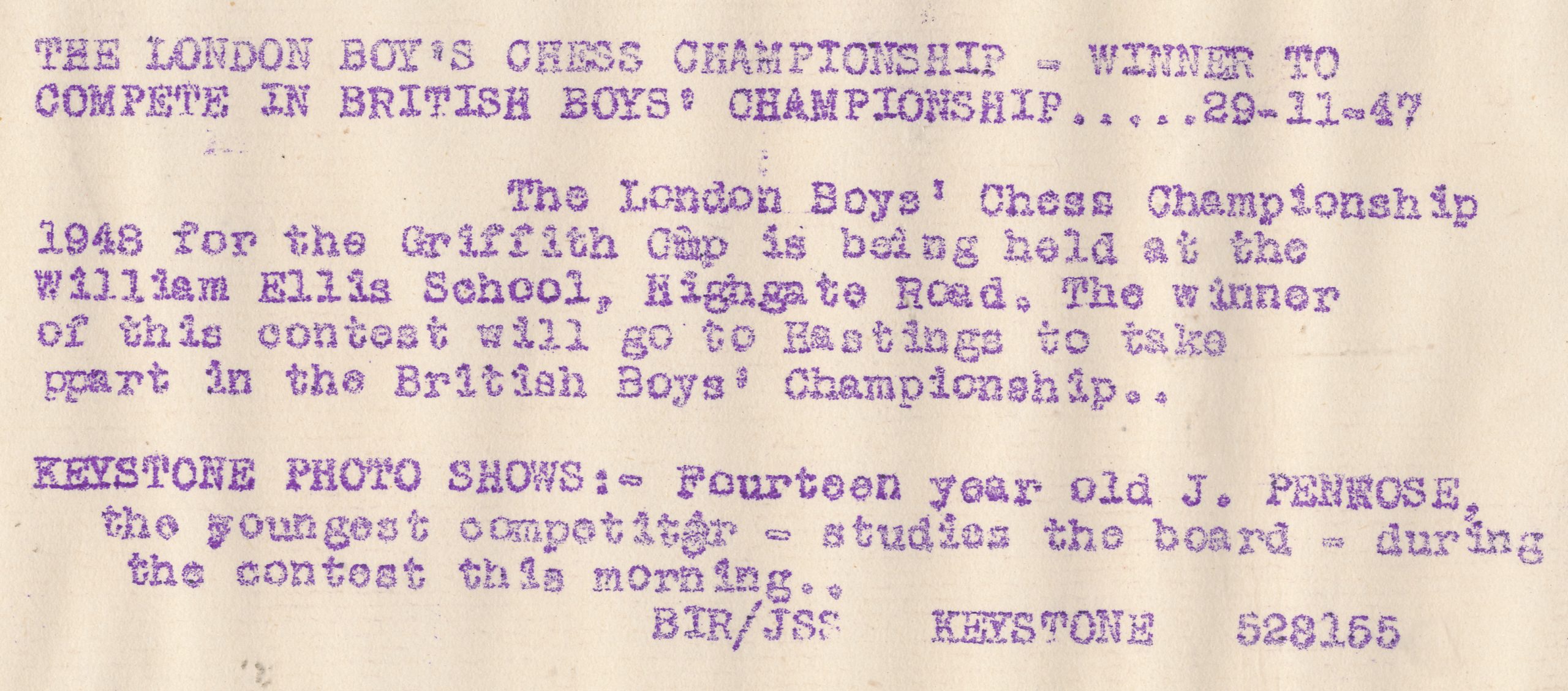
It would be unjust, however, to blame Penrose for any of this. The truth is simply that he was not a professional chessplayer, and indeed he flourished in
a period in which chess playing was not a viable profession in Britain. But even if the material awards available had been greater Penrose would almost certainly have chosen to remain an amateur. For he was cast in that special intellectual and ethical tradition of great British amateurs like H. E. Atkins, Sir George Thomas and Hugh Alexander before him.
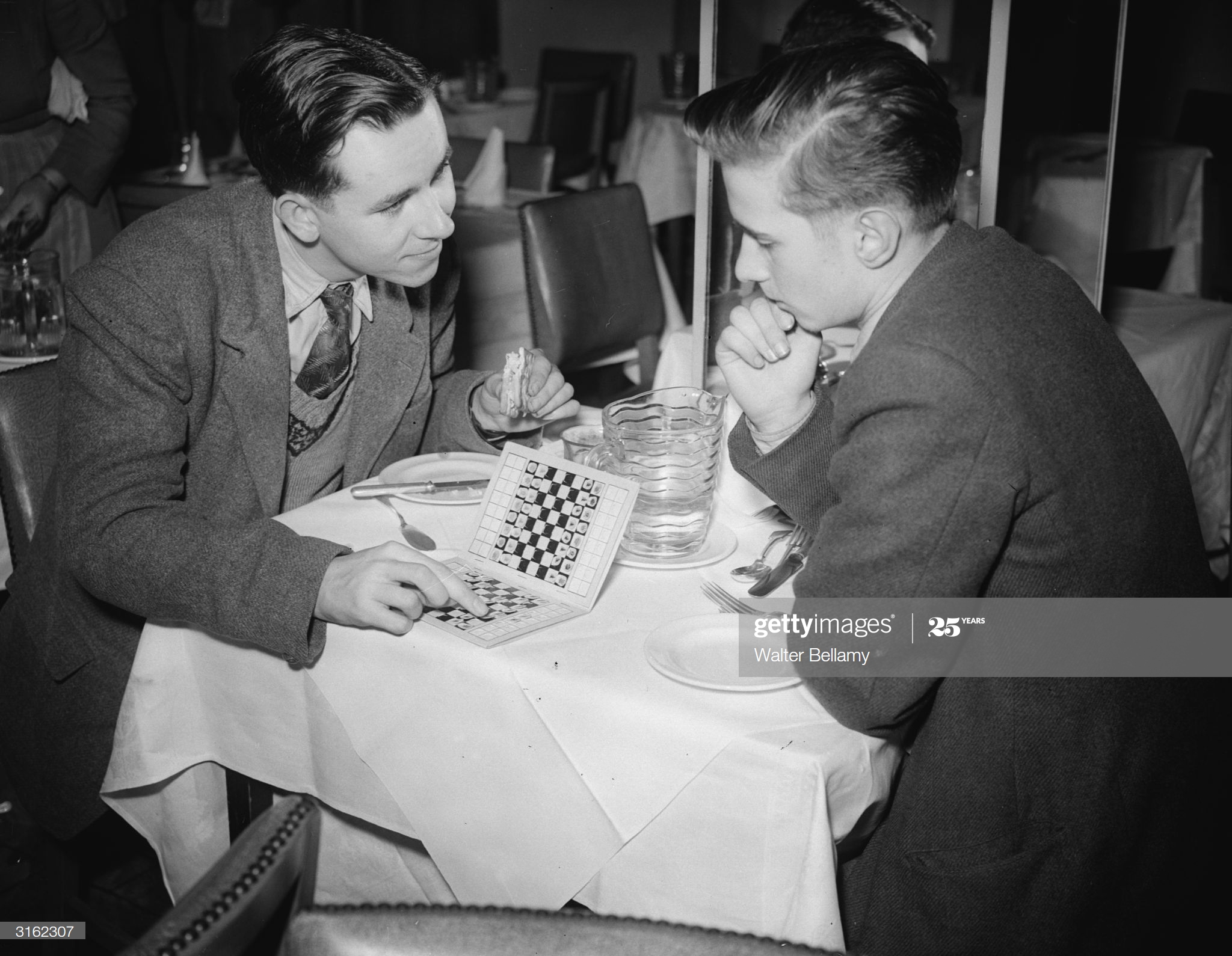
2nd January 1951: British chess champions Jonathan Penrose and Leonard Barden ponder over a portable travel game in a restaurant. (Photo by Walter Bellamy/Express/Getty Images)
His family background indicates early academic inclinations in a cultural atmosphere in which chess was merely a game something at which one excelled through sheer ability, but not to be ranked alongside truly serious work. It is noteworthy that Penrose, unique in this respect amongst British chess
masters, has never written at any length about the game. He has had other matters to concentrate on when away from the board, being a lecturer in psychology. (His father, Professor L. S. Penrose, was a distinguished geneticist.)

Being of slight physique and the mildest and most amiable of characters, it is probably also true that Penrose lacked the toughness and ‘killer instinct’
required to reach the very top. Nervous tension finally struck him down in a dramatic way when he collapsed during play in the Siegen Olympiad of 1970. We
can take that date as the end of the Penrose era.
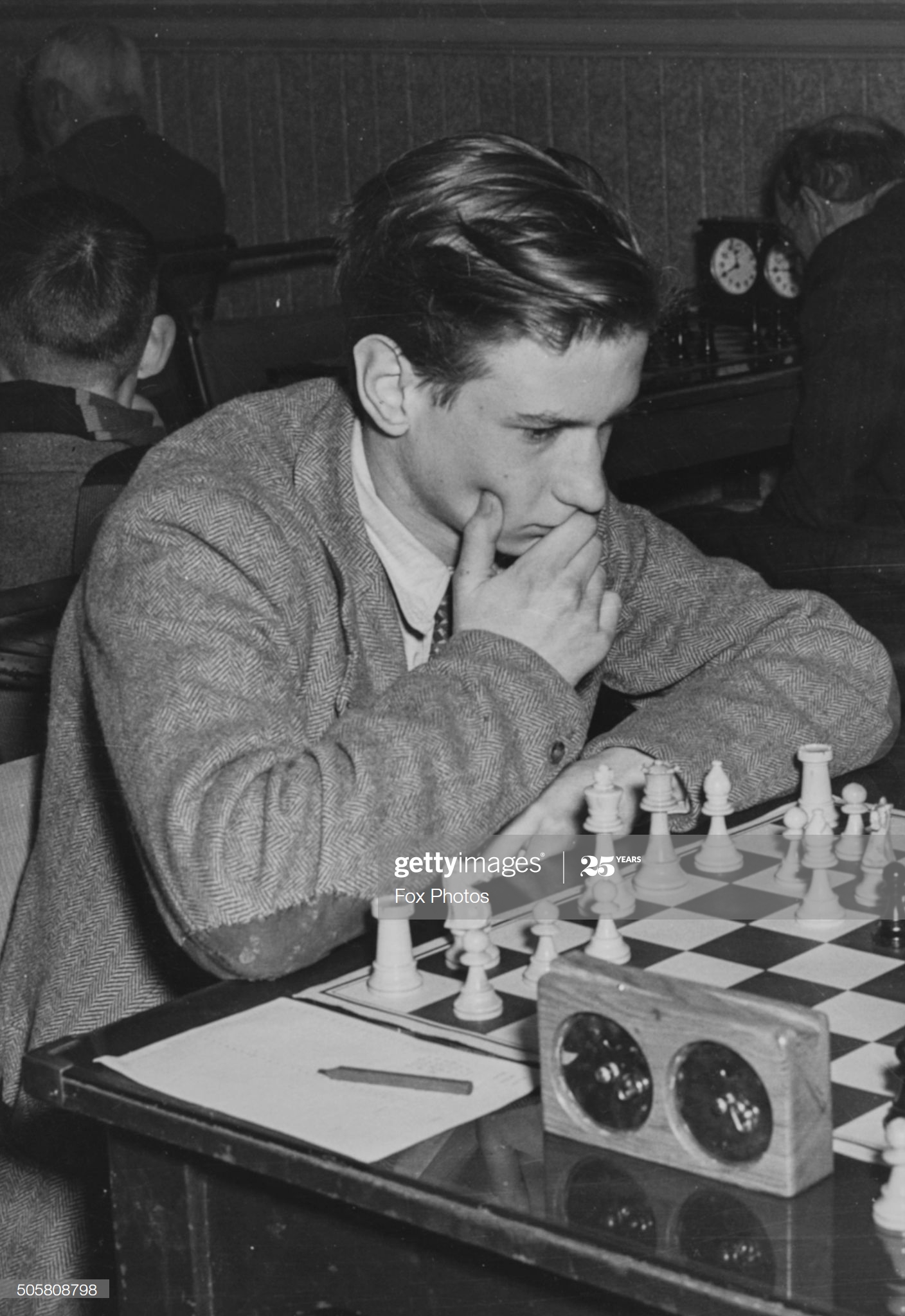
Chess Grandmaster Jonathan Penrose pictured during a chess match, circa 1960. (Photo by Fox Photos/Hulton Archive/Getty Images))
Since, then though he has not by any means entirely given up, his involvement in the nerve-wracking competitions of over-the-board play has been greatly reduced. instead he has turned to correspondence chess, which is perhaps the ideal medium for his clear strategy and deep and subtle analysis. So Penrose’s career it not over. He has moved to another, less stressful province of the kingdom of chess.
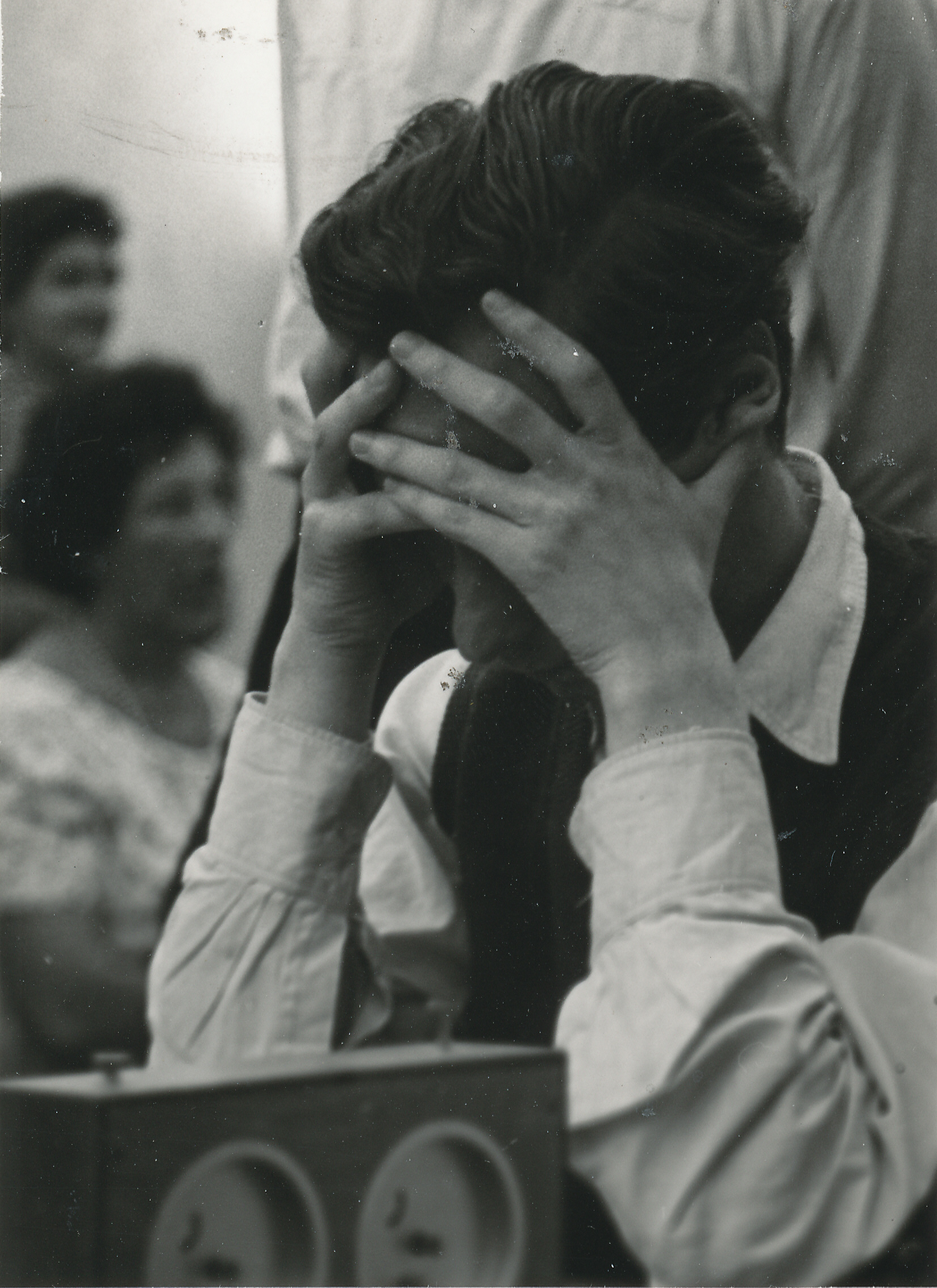
For the first game, however, we shall turn the clock right back to 1950 and the see the Penrose in the role of youthful giant killer.
From The Encyclopedia of Chess (BT Batsford, 1977) by Harry Golombek :
“British international master and ten times British Champion, Penrose was born in Colchester and came from a chess-playing family.
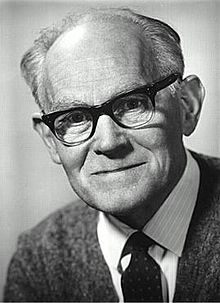
His father and mother both played chess and his father, Professor Lionel Sharples Penrose, in addition or being a geneticist of world-wide fame, was a strong chess-player and a good endgame composer. Jonathan’s older brother Oliver, was also a fine player.
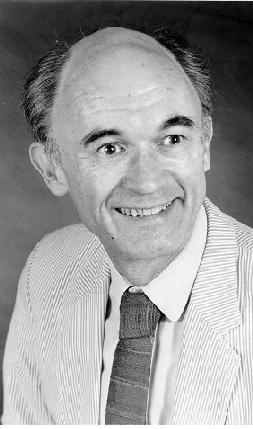
Roger Penrose won the Nobel prize for physics in 2020.
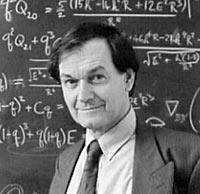
Jonathan learnt chess at the age of four, won the British Boys championship at thirteen and by the time he was fifteen was playing in the British Championship in Felixstowe in 1949.
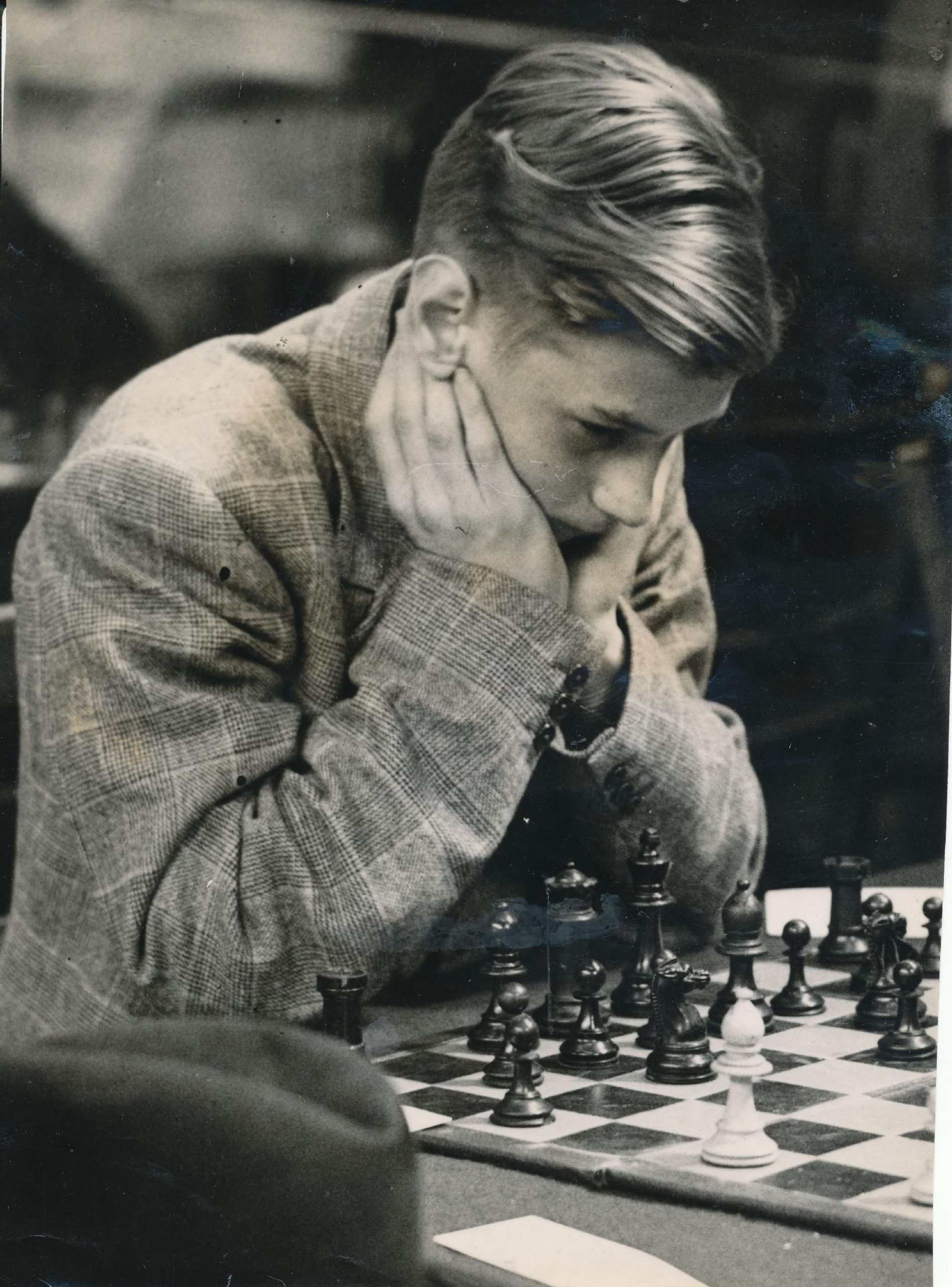
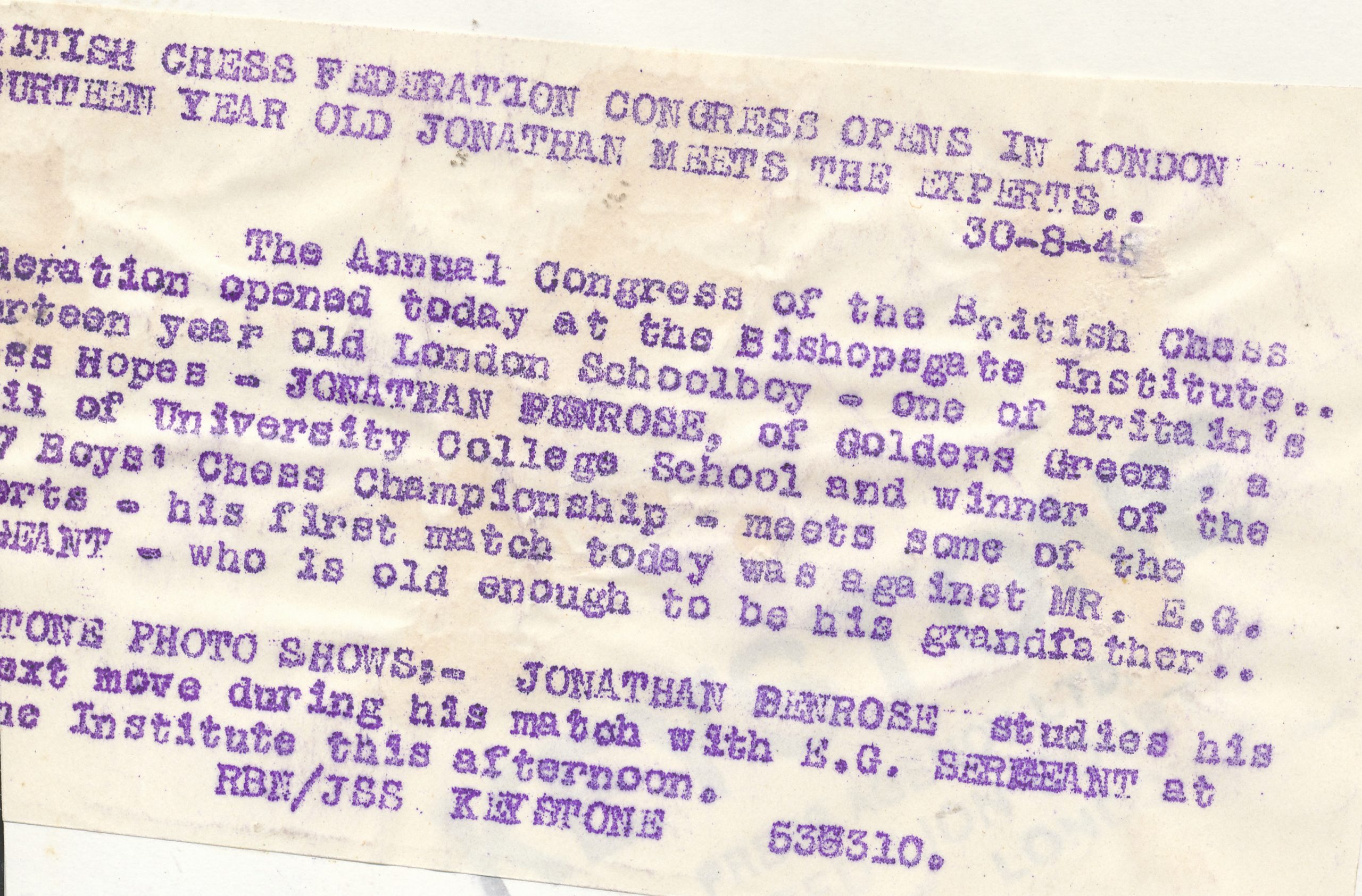
A little reluctant to participate in international tournaments abroad, he did best in the British Championship which he won a record number of times, once more than HE Atkins. He won the title consecutively from 1958 to 1963 and again from 1966 to 1969.
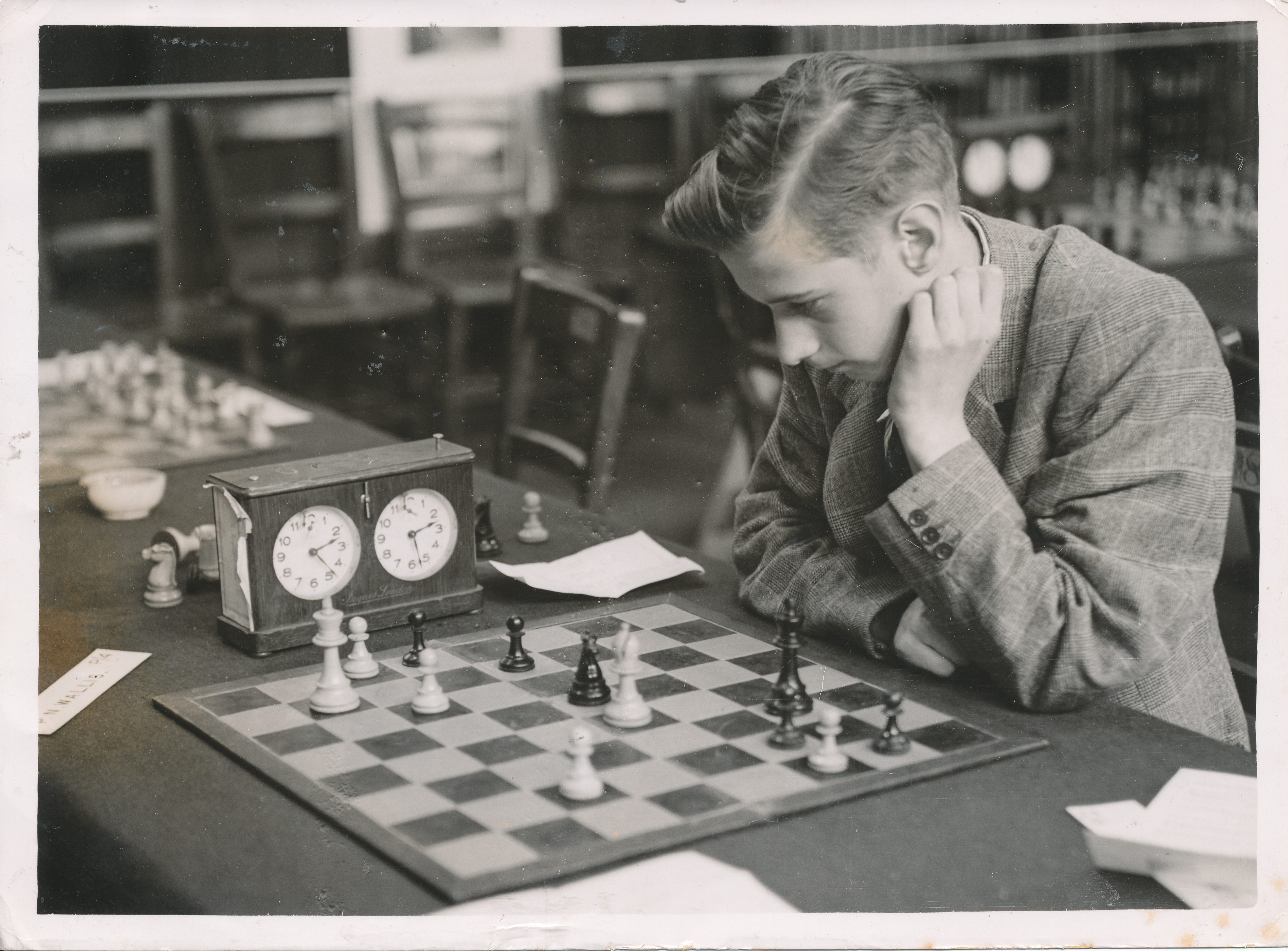
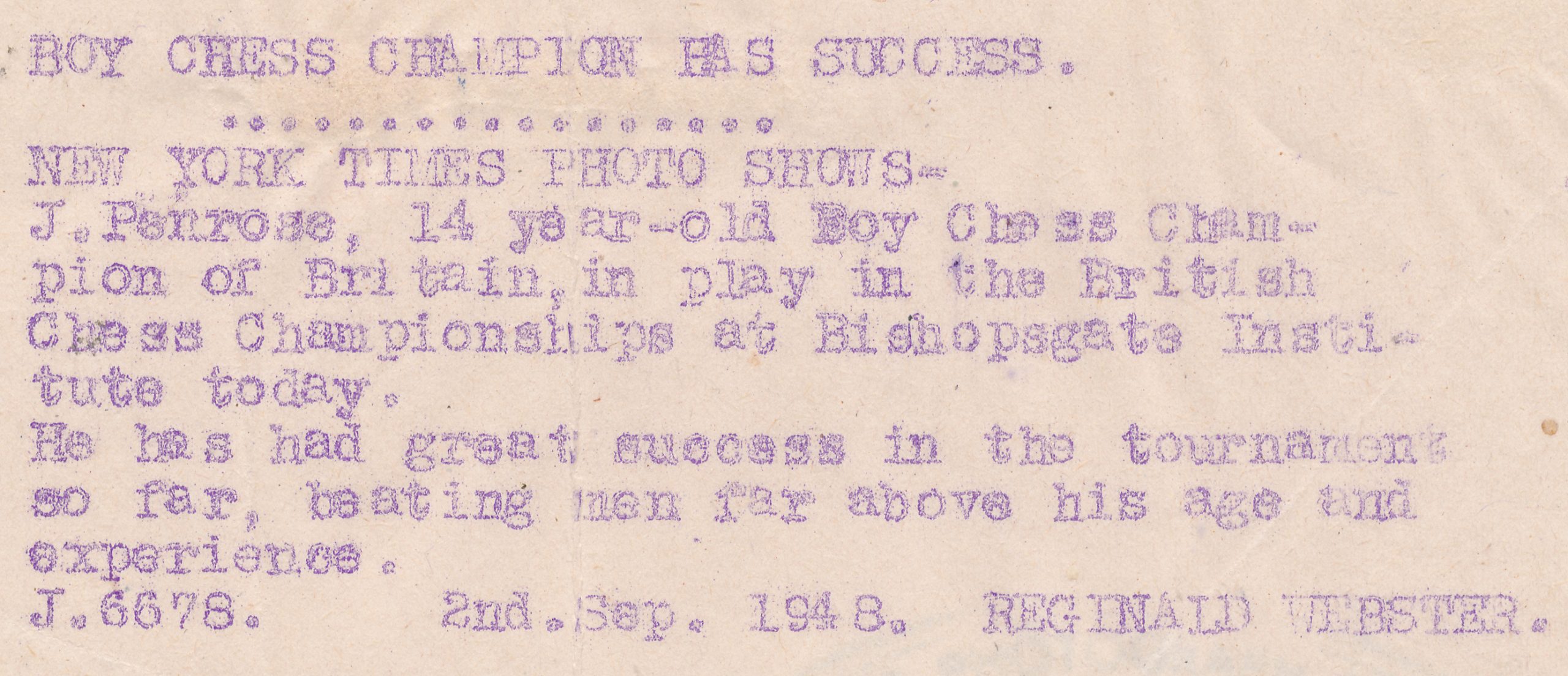
He also played with great effect in nine Olympiads. Playing on a high board for practically all the time, he showed himself the equal of the best grandmasters and indeed, at the Leipzig Olympiad he distinguished himself by beating Mikhail Tal, thereby becoming the first British player to defeat a reigning World Champion since Blackburne beat Lasker in 1899.

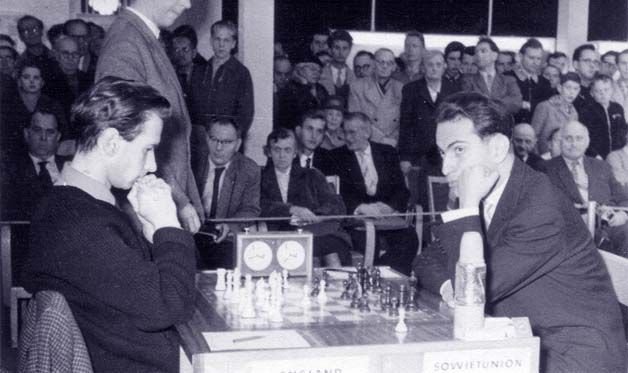
A deep strategist who could also hold his own tactically, he suffered from the defect of insufficient physical stamina and it was this that was to bring about a decline in his play and in his results. He collapsed during a game at the Ilford Chess Congress, and a year later, at the Siegen Olympiad of 1970, he had a more serious collapse that necessitated his withdrawal from the vent after the preliminary groups had been played. The doctors found nothing vitally wrong with him that his physique could not sustain.
He continued to play but his results suffered from a lack of self-confidence and at the Nice Olympiad of 1974 he had a wretched result on board 3, winning only 1 game and losing 6 out of 15.

29th December 1955: Klaus Darga of Germany in play against Britain’s Jonathan Penrose during the International Chess Congress at Hastings. (Photo by Folb/Topical Press Agency/Getty Images)
Possibly too his profession (a lecturer in psychology) was also absorbing him more and more and too part less and less in international and national chess.
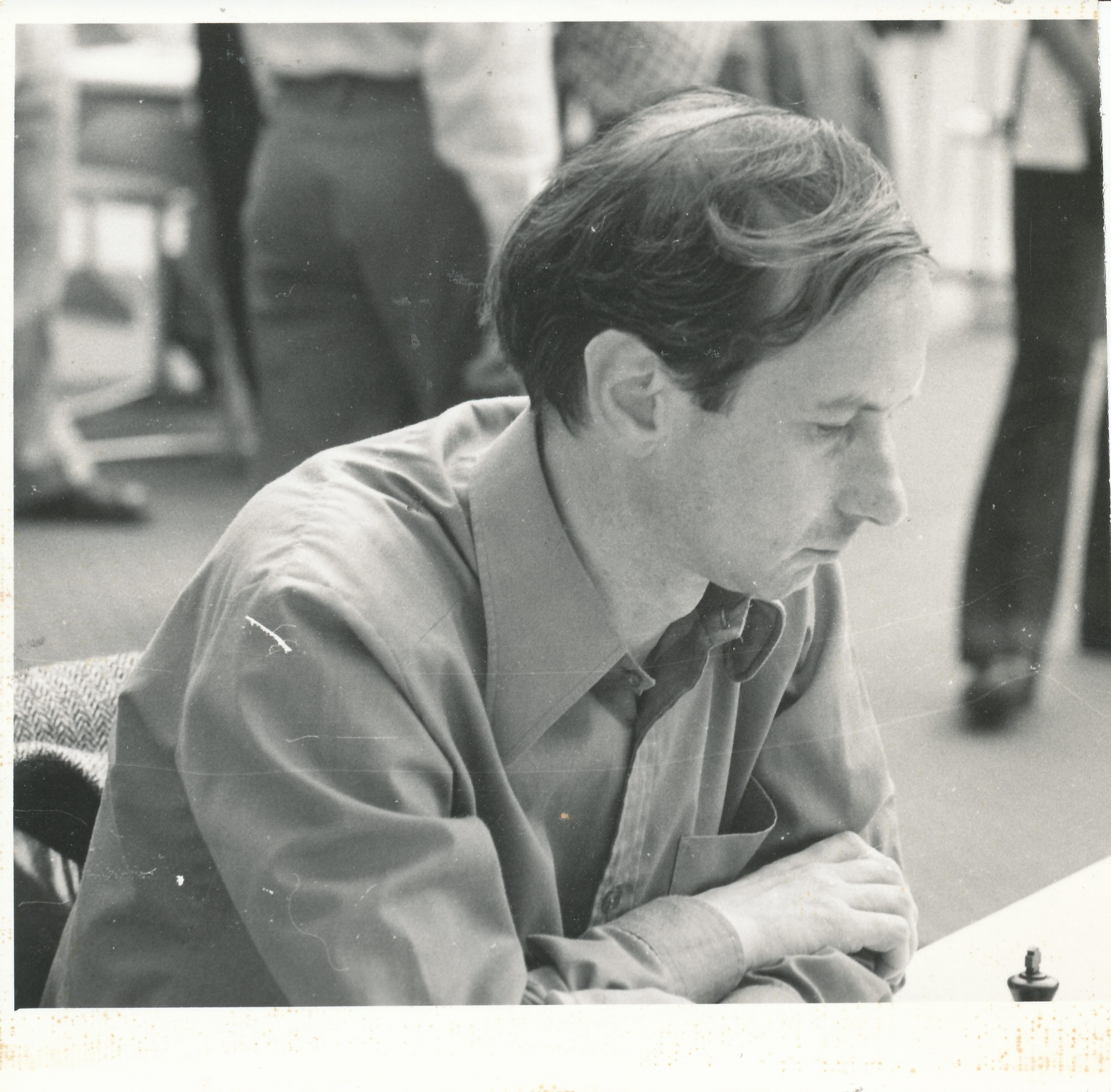
Yet, he had already done enough to show that he was the equal of the greatest British players in his command and understanding of the game and he ranks alongside Staunton, Blackburne, Atkins and CHO’D Alexander as a chess figure of world class.”
Here is his Wikipedia entry
From The Oxford Companion to Chess by Hooper & Whyld :
“The leading English player during the 1960s, International Master (1961), International Correspondence Chess Master (1980), lecturer in psychology. Early in his chess career Penrose decided to remain an amateur and as a consequence played in few international tournaments. He won the British Championship from 1958 to 1963 and from 1966 to 1969, ten times in all (a record); and he played in nine Olympiads from 1952 to 1974, notably scoring + 10=5 on first board at Lugano 1968, a result bettered only by the world champion Petrosyan.
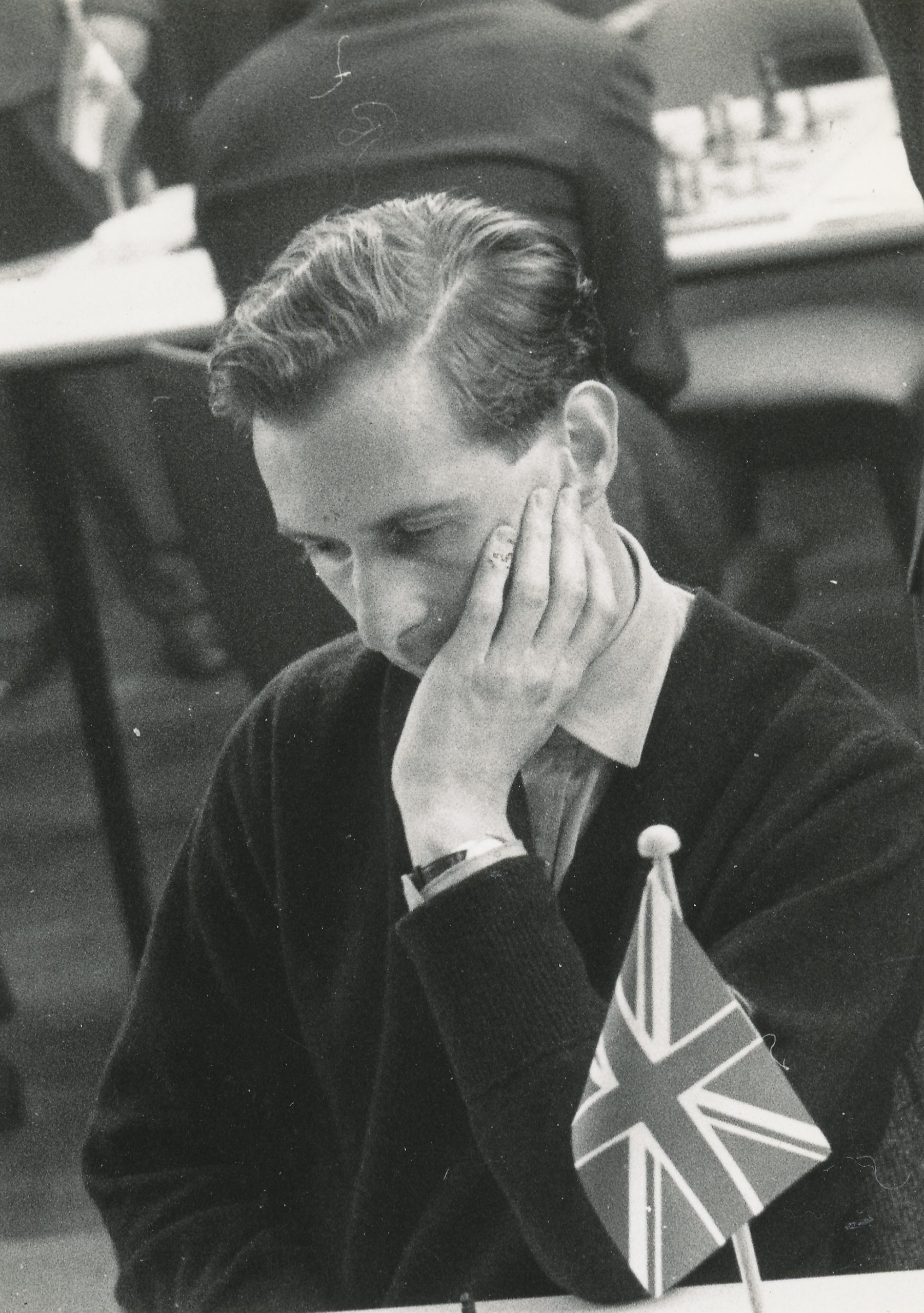
In the early 1970s Penrose further restricted his chess because the stress of competitive play adversely affected his health.”
The second edition (1996) adds this :
“He turned to correspondence play, was the highest rated postal player in the world 1987-9, and led the British team to victory in the 9th Correspondence Olympiad.”
Here is a discussion about Jonathan on the English Chess Forum
From The Encyclopedia of Chess (Robert Hale, 1970 & 1976) by Anne Sunnucks :
“International Master (1961) and British Champion in 1958 1959, 1960, 1961, 1962, 1963, 1966, 1967, 1968 and 1969.
Jonathan Penrose was born in Colchester on 7th October 1933, the son of Professor LS Penrose, the well-known geneticist, who was also a strong player and composer of endgame studies.
The whole Penrose family plays chess and Jonathan learned the game when he was 4. At the age of 12 he joined Hampstead Chess Club and the following year played for Essex for the first time, won his first big tournament, the British Boys’ Championship, and represented England against Ireland in a boy’s match, which was the forerunner of the Glorney Cup competition, which came into being the following year.
By the time he was 17 Penrose was recognised as one of the big hopes of British Chess. Playing in the Hastings Premier Tournament for the first time in `1950 – 1951, he beat the French Champion Nicholas Rossolimo and at Southsea in 1950 he beat two International Grandmasters, Effim Bogoljubov and Savielly Tartakower.
Penrose played for the British Chess Federation in a number of Chess Olympiads since 1952. In 1960, at Leipzig, came one of the best performances of his career, when he beat the reigning World Champion, Mikhail Tal. He became the first British player to beat a reigning World Champion since JH Blackburne beat Emmanuel Lasker in 1899, and the first player to defeat Tal since he won the World Championship earlier that year. Penrose’s score in this Olympiad was only half-a-point short of the score required to qualify for the International Grandmaster title.
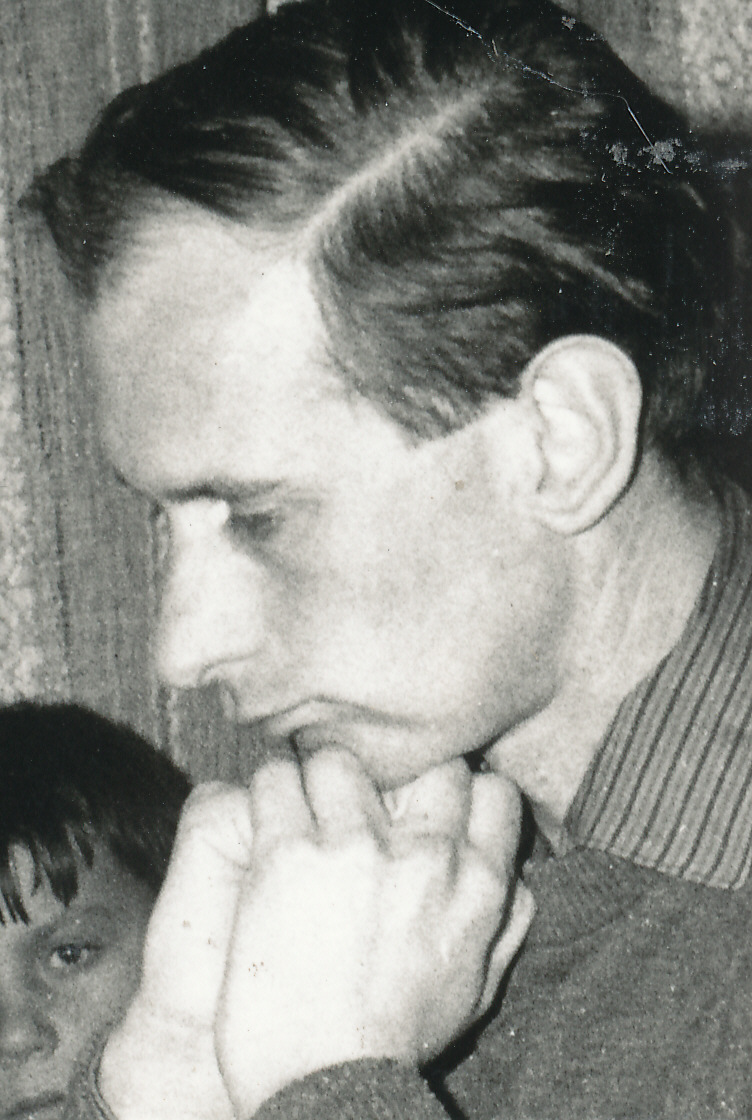
His ninth victory in the British Championships in 1968 equalled the record held by HE Atkins, who has held the title more times than any other player.
Penrose is a lecturer in psychology at Enfield College of Technology and has never been in a position to devote a great deal of time to the game. He is married to a former contender in the British Girls Championship and British Ladies’s Championship, Margaret Wood, daughter of Frank Wood, Hon. Secretary of the Oxfordshire Chess Association.
Penrose was awarded the O.B.E. for his services to chess in 1971.”
Penrose was Southern Counties Champion for 1949-50.
In 1983 Jonathan became England’s fifth Correspondence Grandmaster (CGM) following Keith Richardson, Adrian Hollis, Peter Clarke and Simon Webb.
Sadly, there is no existent book on the life and games of Jonathan Penrose : a serious omission in chess literature.

Remembering GM Dr. Jonathan Penrose OBE (07-x-1933 30-xi-2021)
BCN remembers GM Dr. Jonathan Penrose OBE who passed away on Tuesday, November 30th, 2021.
In the 1971 New Years Honours List Jonathan was made an Officer of the Order of the British Empire (OBE) The citation read “For services to Chess.”
In 1993 following representations by Bob Wade and Leonard Barden FIDE granted the title of Grandmaster to Jonathan. Here is a detailed discussion of that process. Note that this was not an Honorary title (as received by Jacques Mieses and Harry Golombek).
From British Chess (Pergamon Press, 1983) by Botterill, Levy, Rice and Richardson : (article by George Botterill)
“Penrose is one of the outstanding figures of British chess. Yet many who meet him may not realize this just because he is one of the quietest and most modest of men. Throughout the late 1950s and the whole of the 1960s he stood head and shoulders above any of his contemporaries.


His extraordinary dominance is revealed by the fact that he won the British championship no less than ten times (1958-63 and 1966-69, inclusive), a record that nobody is likely to equal in the future.
At his best his play was lucid, positionally correct, energetic and tactically acute. None the less, there is a ‘Penrose problem’: was he a ‘Good Thing’ for British chess? The trouble was that whilst this highly talented player effectively crushed any opposition at home, he showed little initiative in flying the flag abroad. There is a wide-spread and justifiable conviction that only lack of ambition in the sphere of international chess can explain why he did not secure the GM title during his active over-the-board playing career.


It would be unjust, however, to blame Penrose for any of this. The truth is simply that he was not a professional chessplayer, and indeed he flourished in
a period in which chess playing was not a viable profession in Britain. But even if the material awards available had been greater Penrose would almost certainly have chosen to remain an amateur. For he was cast in that special intellectual and ethical tradition of great British amateurs like H. E. Atkins, Sir George Thomas and Hugh Alexander before him.

2nd January 1951: British chess champions Jonathan Penrose and Leonard Barden ponder over a portable travel game in a restaurant. (Photo by Walter Bellamy/Express/Getty Images)
His family background indicates early academic inclinations in a cultural atmosphere in which chess was merely a game something at which one excelled through sheer ability, but not to be ranked alongside truly serious work. It is noteworthy that Penrose, unique in this respect amongst British chess masters, has never written at any length about the game. He has had other matters to concentrate on when away from the board, being a lecturer in psychology. (His father, Professor L. S. Penrose, was a distinguished geneticist.)

Being of slight physique and the mildest and most amiable of characters, it is probably also true that Penrose lacked the toughness and ‘killer instinct’ required to reach the very top. Nervous tension finally struck him down in a dramatic way when he collapsed during play in the Siegen Olympiad of 1970. We can take that date as the end of the Penrose era.

Chess Grandmaster Jonathan Penrose pictured during a chess match, circa 1960. (Photo by Fox Photos/Hulton Archive/Getty Images))
Since, then though he has not by any means entirely given up, his involvement in the nerve-wracking competitions of over-the-board play has been greatly reduced. instead he has turned to correspondence chess, which is perhaps the ideal medium for his clear strategy and deep and subtle analysis. So Penrose’s career it not over. He has moved to another, less stressful province of the kingdom of chess.

For the first game, however, we shall turn the clock right back to 1950 and the see the Penrose in the role of youthful giant killer.
From The Encyclopedia of Chess (BT Batsford, 1977) by Harry Golombek :
“British international master and ten times British Champion, Penrose was born in Colchester and came from a chess-playing family.

His father and mother (Margaret) both played chess and his father, Professor Lionel Sharples Penrose, in addition to being a geneticist of world-wide fame, was a strong chess-player and a good endgame composer. Jonathan’s older brother Oliver, was also a fine player.

Roger Penrose won the Nobel prize for physics in 2020.

Shirley Hodgson (née Penrose) is a high flying geneticist.
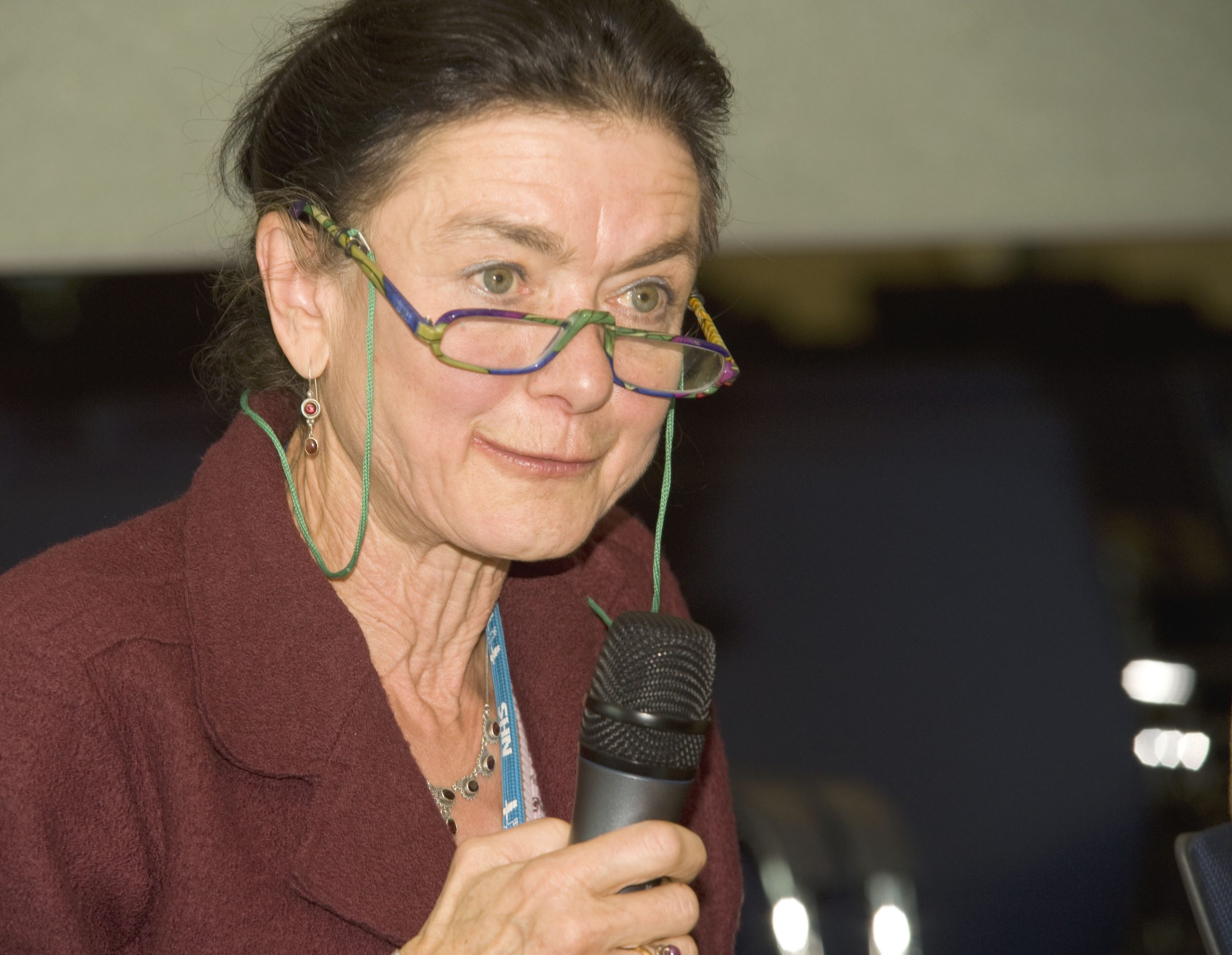
Jonathan learnt chess at the age of four, won the British Boys championship at thirteen and by the time he was fifteen was playing in the British Championship in Felixstowe in 1949.


A little reluctant to participate in international tournaments abroad, he did best in the British Championship which he won a record number of times, once more than HE Atkins. He won the title consecutively from 1958 to 1963 and again from 1966 to 1969.


He also played with great effect in nine Olympiads. Playing on a high board for practically all the time, he showed himself the equal of the best grandmasters and indeed, at the Leipzig Olympiad he distinguished himself by beating Mikhail Tal, thereby becoming the first British player to defeat a reigning World Champion since Blackburne beat Lasker in 1899.


A deep strategist who could also hold his own tactically, he suffered from the defect of insufficient physical stamina and it was this that was to bring about a decline in his play and in his results. He collapsed during a game at the Ilford Chess Congress, and a year later, at the Siegen Olympiad of 1970, he had a more serious collapse that necessitated his withdrawal from the event after the preliminary groups had been played. The doctors found nothing vitally wrong with him that his physique could not sustain.
He continued to play but his results suffered from a lack of self-confidence and at the Nice Olympiad of 1974 he had a wretched result on board 3, winning only 1 game and losing 6 out of 15.

29th December 1955: Klaus Darga of Germany in play against Britain’s Jonathan Penrose during the International Chess Congress at Hastings. (Photo by Folb/Topical Press Agency/Getty Images)
Possibly too his profession (a lecturer in psychology) was also absorbing him more and more and too part less and less in international and national chess.

Yet, he had already done enough to show that he was the equal of the greatest British players in his command and understanding of the game and he ranks alongside Staunton, Blackburne, Atkins and CHO’D Alexander as a chess figure of world class.”
Here is his Wikipedia entry
From The Oxford Companion to Chess by Hooper & Whyld :
“The leading English player during the 1960s, International Master (1961), International Correspondence Chess Master (1980), lecturer in psychology. Early in his chess career Penrose decided to remain an amateur and as a consequence played in few international tournaments. He won the British Championship from 1958 to 1963 and from 1966 to 1969, ten times in all (a record); and he played in nine Olympiads from 1952 to 1974, notably scoring + 10=5 on first board at Lugano 1968, a result bettered only by the world champion Petrosyan.

In the early 1970s Penrose further restricted his chess because the stress of competitive play adversely affected his health.”
The second edition (1996) adds this :
“He turned to correspondence play, was the highest rated postal player in the world 1987-9, and led the British team to victory in the 9th Correspondence Olympiad.”
Here is a discussion about Jonathan on the English Chess Forum
From The Encyclopedia of Chess (Robert Hale, 1970 & 1976) by Anne Sunnucks :
“International Master (1961) and British Champion in 1958 1959, 1960, 1961, 1962, 1963, 1966, 1967, 1968 and 1969.
Jonathan Penrose was born in Colchester on 7th October 1933, the son of Professor LS Penrose, the well-known geneticist, who was also a strong player and composer of endgame studies.
The whole Penrose family plays chess and Jonathan learned the game when he was 4. At the age of 12 he joined Hampstead Chess Club and the following year played for Essex for the first time, won his first big tournament, the British Boys’ Championship, and represented England against Ireland in a boy’s match, which was the forerunner of the Glorney Cup competition, which came into being the following year.
By the time he was 17 Penrose was recognised as one of the big hopes of British Chess. Playing in the Hastings Premier Tournament for the first time in `1950 – 1951, he beat the French Champion Nicholas Rossolimo and at Southsea in 1950 he beat two International Grandmasters, Effim Bogoljubov and Savielly Tartakower.
Penrose played for the British Chess Federation in a number of Chess Olympiads since 1952. In 1960, at Leipzig, came one of the best performances of his career, when he beat the reigning World Champion, Mikhail Tal. He became the first British player to beat a reigning World Champion since JH Blackburne beat Emmanuel Lasker in 1899, and the first player to defeat Tal since he won the World Championship earlier that year. Penrose’s score in this Olympiad was only half-a-point short of the score required to qualify for the International Grandmaster title.

His ninth victory in the British Championships in 1968 equalled the record held by HE Atkins, who has held the title more times than any other player.
Penrose is a lecturer in psychology at Enfield College of Technology and has never been in a position to devote a great deal of time to the game. He is married to a former contender in the British Girls Championship and British Ladies’s Championship, Margaret Wood, daughter of Frank Wood, Hon. Secretary of the Oxfordshire Chess Association.
Again from British Chess : “In updating this report we find striking evidence of Penrose’s prowess as a correspondence player. Playing on board 4 for Britain in the 8th Correspondence Chess Olympiad he was astonishingly severe on the opposition, letting slip just one draw in twelve games! Here is one of the eleven wins that must change the assessment of a sharp Sicilian Variation.”
Penrose was awarded the O.B.E. for his services to chess in 1971.”
Penrose was Southern Counties Champion for 1949-50.
In 1983 Jonathan became England’s fifth Correspondence Grandmaster (CGM) following Keith Richardson, Adrian Hollis, Peter Clarke and Simon Webb.
Sadly, there is no existent book on the life and games of Jonathan Penrose : a serious omission in chess literature.


